i 2024 600R Owner’s Manual

|
|
2024 Owner’s Manual 600R |
The Owner's Manual for this vehicle contains warnings, instructions and other information you must read and fully understand before safely riding or performing maintenance on this vehicle. Always follow the warnings and instructions in Owner's Manual.
Click the link above for the Table Of Contents, or download a full PDF of the Owner Manual in the Owner Support area of Polaris.com.

|
|
2024 Owner’s Manual 600R |
Unless noted, trademarks are the property of Polaris Industries Inc.
Allen® is a registered trademark of APEX BRANDS, INC. QR Code® is a registered trademark of DENSO WAVE INCORPORATED. NGK® is a registered trademark of NGK Spark Plug Co., Ltd. FOX® is a registered trademark of Fox Factory Inc. SAE® is a registered trademark of Society of Automotive Engineers, Inc. Hayes® is a registered trademark of Hayes Bicycle Group, Inc. WALKER EVANS RACING® is a registered trademark of Walker Evans Enterprises Incorporated.
Copyright 2023 Polaris Industries Inc. All information contained within this publication is based on the latest product information at the time of publication. Due to constant improvements in the design and quality of production components, some minor discrepancies may result between the actual vehicle and the information presented in this publication. Depictions and/or procedures in this publication are intended for reference use only. No liability can be accepted for omissions or inaccuracies. Any reprinting or reuse of the depictions and/or procedures contained within, whether whole or in part, is expressly prohibited.
The original instructions for this vehicle are in English. Other languages are provided as translations of the original instructions.
Printed in U.S.A.

Thank you for purchasing a Polaris vehicle, and welcome to our world-wide family of Polaris enthusiasts. Be sure to visit us online at www.polaris.com for the latest news, new product introductions, upcoming events, career opportunities and more.
Here at Polaris we proudly produce an exciting line of utility and recreational products. We believe Polaris sets a standard of excellence for all utility and recreational vehicles manufactured in the world today. Many years of experience have gone into the engineering, design, and development of your Polaris vehicle, making it the finest machine we’ve ever produced.
For safe and enjoyable operation of your vehicle, be sure to follow the instructions and recommendations in this owner’s manual. Your manual contains instructions for minor maintenance, but information about major repairs is outlined in the Polaris Service Manual and can be performed by a factory certified Master Service Dealer (MSD) technician.
Your Polaris dealer knows your vehicle best and is interested in your total satisfaction. Your Polaris dealership can perform all of your service needs during and after the warranty period.
For the most up-to-date owner’s manual visit https://www.polaris.com/en-us/owners-manuals.
The following signal words and symbols appear throughout this manual and on your vehicle. Your safety is involved when these words and symbols are used. Become familiar with their meanings before reading the manual.
DANGER indicates a hazardous situation which, if not avoided, WILL result in death or serious injury.
WARNING indicates a hazardous situation which, if not avoided, COULD result in death or serious injury.
CAUTION indicates a hazardous situation which, if not avoided, COULD result in minor to moderate injury.
NOTICE provides key information by clarifying instructions.
IMPORTANT provides key reminders during disassembly, assembly, and inspection of components.
The Prohibition Safety Sign indicates an action NOT to take in order to avoid a hazard.

The Mandatory Action Sign indicates an action that NEEDS to be taken to avoid a hazard.

After reading this manual, store it in the snowmobile for convenient reference. It should remain with the snowmobile when the snowmobile is sold.
Some of the illustrations and photos used in this manual are general representations. Your model may differ.
Follow the maintenance program outlined in this manual. Preventive maintenance ensures that critical components of the snowmobile are inspected at specific mileage intervals. This service can be performed by your authorized Polaris dealer.
You and your dealer must complete the registration form included with your snowmobile and forward it to us. This completed form is necessary to ensure warranty coverage.
Protect and preserve your right to ride by joining your local trail riding clubs.
When teaching inexperienced operators to ride, set up a predetermined course for practice. Make sure they know how to drive and control the snowmobile before allowing them to make longer trips. Teach them proper snowmobile courtesy, and enroll them in driver’s training and safety courses sponsored by local or state organizations.
Polaris is committed to supporting an environmental education campaign. We encourage state and provincial governments across the snowbelt to adopt rigorous safety training programs that encourage protection of our environment, including wildlife and vegetation.
Snowmobile clubs and other organizations are working together to protect our environment. Please support their efforts and operate your snowmobile with consideration for the protection and preservation of our environment.
One of the most publicized issues about snowmobiles is noise. The Society of Automotive Engineers (SAE®), the standard-setting body for snowmobile development, recommends that snowmobiles conform to prescribed sound levels.
Polaris snowmobiles are engineered to conform to these SAE® standards. Our muffler systems are designed to reduce noise levels and must not be altered or removed. The sound of your snowmobile may not be welcome to non-snowmobilers, so you have a responsibility to operate your snowmobile with concern for others. We do our part by manufacturing quieter machines; we ask your help to further reduce the impact of noise by operating your snowmobile safely and responsibly.
Polaris engineers continuously investigate ways to reduce emission levels of two-stroke engines. We expect our efforts to lead to the reduction of potential air pollution.
In addition to our technological research, we encourage government agencies, manufacturers, distributors, dealers, ecologists, and other interested parties to work together to develop data on environmental topics.
The engine serial number 1 is located on the identification label on the engine recoil cover.

To report a safety defect to Transport Canada, you may either fill out an online defect complaint form at their website (English: http://www/tc/gc/ca/recalls, French: http://www.tc.gc.ca/rappels) or contact their Defect Investigations and Recalls Division by calling toll-free 1-800-333-0510 (Canada) or 819-994-3328 (Ottawa-Gatineau area / International).
Follow the recommended maintenance program beginning on POLARIS Recommended Maintenance Program of this manual to ensure that all critical components on the snowmobile are thoroughly inspected at specific mileage intervals. Your dealer can perform this service.
Snowmobiles are capable of traveling at high speeds. Use extra caution to ensure operator safety. Make sure your snowmobile is in excellent operating condition at all times. Always check major and vital safety components before every ride.
All Polaris snowmobiles are designed and tested to provide safe operation when used as directed. Failure of critical machine components may result from operation with any modifications, especially those that increase speed or power. DO NOT MODIFY YOUR MACHINE. The snowmobile may become aerodynamically unstable at speeds higher than those for which it is designed. Loss of control may occur at higher speeds. Modifications may also create a safety hazard and lead to bodily injury.
The warranty on your entire machine is terminated if any equipment has been added, or any modifications have been made, to increase the speed or power of the snowmobile.
Your snowmobile is propelled by a revolving track that must be partially exposed for proper operation. Do not stand on the plastic flap.
Never attempt adjustments with the engine running. Turn off the ignition, open the side panels or hood, make the adjustment, secure shields and guards, secure the side panels and hood, and then restart the engine to check its operation.
Operating a snowmobile requires skill and balance for proper control. Rider positions may vary with experience and the features available on some snowmobiles, but under many conditions, the proper position is to be seated with both feet on the running boards and both hands on the handlebar grips for proper throttle, brake and steering control.
This snowmobile is designed for a single rider only. Never carry a passenger on this snowmobile.
Wearing a helmet can prevent a severe head injury. Whenever riding this Polaris vehicle, always wear a helmet that meets or exceeds established safety standards. Clasp the buckle and pull each strap tight to ensure the helmet is properly secured to the head.
Parents should verify that young operators have a helmet that fits, and should obtain one of proper size if it does not fit before allowing operation.
Approved helmets in the USA and Canada bear a U.S. Department of Transportation (DOT) label.

Approved helmets in Europe, Asia and Oceania bear the ECE 22.05 label. The ECE mark consists of a circle surrounding the letter E, followed by the distinguishing number of the country which has granted approval. The approval number and serial number will also be displayed on the label.

Do not depend on eyeglasses or sunglasses for eye protection. Whenever riding a Polaris vehicle, always wear shatterproof goggles or use a shatterproof helmet face shield. Polaris recommends wearing approved Personal Protective Equipment (PPE) bearing markings such as VESC 8, V-8, Z87.1, or CE. Make sure protective eye wear is kept clean.
Be prepared, be warm and be comfortable when riding. Be aware of the weather forecast, especially the windchill, and dress accordingly. See Windchill/Temperature Charts.
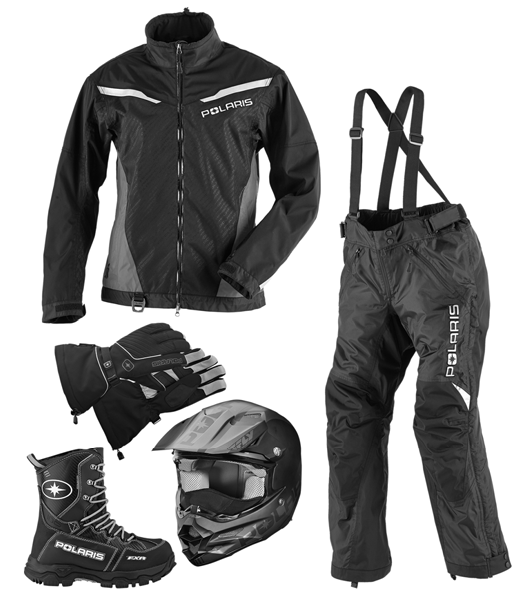
For your safety, always ride in a group of other snowmobilers. Always tell someone where you're going and how long you expect to be gone. If it isn't possible to ride with others, and you must travel into remote areas, always carry survival equipment that's appropriate to the conditions you may encounter. Such equipment may include, but is not limited to: extra clothing, a sleeping bag, a flashlight, food and water, a signaling mirror, a means of building a fire, and a two-way radio or cellular telephone.
Always carry the owner’s manual on your snowmobile. For added protection, purchase and carry the following items on your snowmobile as well:
Spare Drive Belt
Extra Set of Spark Plugs
Tow Rope
Fuel Deicer
Winter Survival Kit
Trail Map
First Aid Kit
Tool Kit
Always observe all state and local laws governing snowmobile operation and speed limits. Always be alert and pay attention to the trail ahead. If your speed is 40 MPH (64 km/h), your snowmobile is traveling about 60 feet (18 m) per second. If you look back for only two seconds, your snowmobile will travel about 120 feet (36 m). If your speed is 60 MPH (96 km/h), your snowmobile will travel about 180 feet (55 m) in two seconds.
Traveling at night requires extra caution. Check headlight and taillight to ensure proper operation, and don’t over-drive your headlight beam. Always be able to bring your snowmobile to a stop in the distance illuminated by the headlight.
Slow down when traveling near poles, posts, or other obstacles. Be especially alert if you're snowmobiling after dark. Always be on the alert for wire fences. Single strands are especially dangerous, since there may be a great distance between posts. Guy wires on utility poles are also difficult to distinguish.
Make sure the way is clear before crossing railroads and other roads and highways. The noise of your snowmobile will drown out the sound of approaching vehicles and bare roads limit the effectiveness of the steering system. Look ahead, behind, and to both sides before turning or crossing railroad tracks or highways. Steep embankments may also hide your view. Always leave yourself a way out.
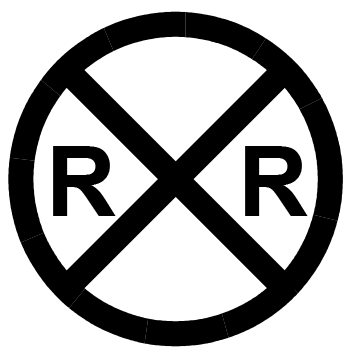
Variances in snow depth and/or water currents may result in uneven ice thickness. You may drown if you break through the ice. Never travel on frozen bodies of water unless you have first verified that the ice is sufficiently thick to support the weight and moving force of the snowmobile, you and your cargo, together with any other vehicles in your party. Always check with local authorities and residents to confirm ice conditions and thickness over your entire route. Snowmobile operators assume all risk associated with ice conditions on frozen bodies of water.
When teaching inexperienced operators to ride, set up a predetermined course for practice. Make sure they know how to drive and control the snowmobile before allowing them to make longer trips. Teach them proper snowmobile courtesy, and enroll them in driver's training and safety courses.
Safe operation of this rider-active vehicle requires good judgement and physical skills. Operators with cognitive or physical disabilities have an increased risk of loss of control, which could result in serious injury or death.
Mountainous terrain operation, even for experienced riders, can present conditions and situations that could result in serious injury or death. Please review all of the information about riding in mountainous terrain on the following pages of this manual.
The avalanche information provided in this manual should be considered basic information and is not intended to replace your participation in an avalanche safety training course. After reviewing the avalanche information in this manual, be sure to participate in an avalanche safety training course before riding in mountainous terrain. The training course will provide more information as well as the opportunity to practice riding and using proper search and recovery techniques.
For more information, education, training courses, and links to additional resources, visit:
www.avalanche.org for North American riders.
www.avalanche.ca for Canadian riders.
www.lavinprognoser.se for Swedish riders.
www.avalanches.org for European riders.
In addition to carrying a spare belt, spark plugs and tools on each snowmobile, each person in your riding group should wear the recommended snowmobile riding apparel and carry (on their person) the following survival items when riding in mountainous terrain:
A digital avalanche beacon with new “fresh” alkaline batteries
An avalanche probe
A compact shovel and hand saw
A backpack (preferably an avalanche air bag backpack)
Emergency provisions, including the following items:
Small first aid kit
Extra pair of gloves
Extra dry socks
Tow rope, map, compass/GPS
Lighter or waterproof matches
Signal mirror and whistle
Bottled water
High calorie snack food
Compact emergency blanket
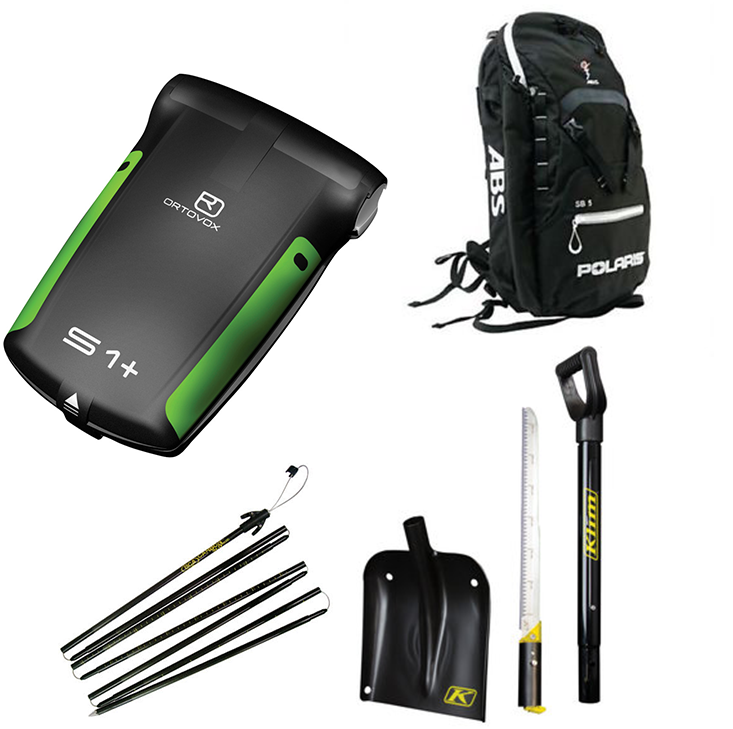
Following the safety gear and apparel recommendations will increase your chances of survival if you encounter an avalanche or become stranded in the backcountry, but even experienced and properly-equipped snowmobilers, hikers and skiers perish in avalanches or succumb to hypothermia. Using a beacon or probe for the first time during an avalanche recovery operation, or not knowing how to deploy your avalanche air bag backpack during a slide, should be considered UNACCEPTABLE to you and all members of your riding group. It’s critical that you and all members of your riding group know how to use the safety gear.
While you may know how to use your gear, you may have to rely on your riding group to find you in an avalanche. Make sure they know how to use their gear.
Dress in layers. Multiple layers of clothing provide the best barrier to cold and wind. Layers can be removed, but if you start out without enough layers, they cannot be added later. Avoid cotton materials, which will freeze if they get wet.
Wear highly visible gear.
Try on all gear and equipment to make sure it fits and doesn’t interfere with your riding capabilities. Place all survival aids in your backpack and wear the backpack at all times. Non-essential items can be stored on the snowmobile in an accessory bag.
Read and follow the manufacturer’s user and maintenance instructions for all gear. If you have questions about how your gear works, contact the manufacturer for more information.
Practice using your beacons, shovels and probes with your riding group in real-world conditions wearing all of your gear. Have someone hide an active “transmitting” beacon by throwing it (not walking it) into a snowbank and timing your group’s search for it.
Test deploying your gear. If you own an avalanche air bag backpack, check with the manufacturer’s test deployment guidelines and bottle weight replacement specifications. Most air bag backpack manufacturers recommend testing the pack once a year so you know it works and feel comfortable with the bag and deployment time.
Make sure your probe and shovel are in good condition and that you know how to assemble them.
Slopes steeper than 30º are more prone to avalanches, but any slope should be considered avalanche terrain, even small slopes with trees. Low-angle slopes are also avalanche terrain if they have steeper slopes above them.
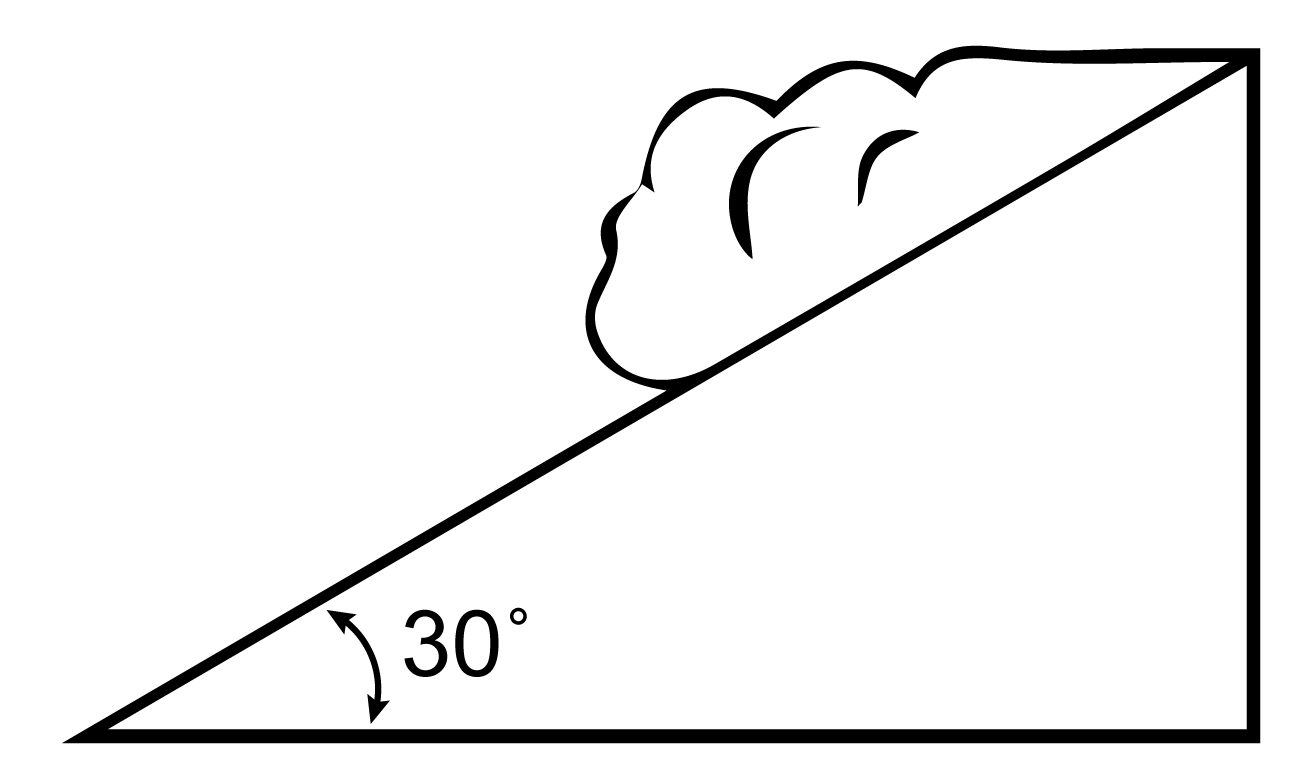
Always look for the following warning signs of unstable snow. If you see or hear any of these signs, riding on or below any slope is dangerous and should be avoided:
Recent avalanches
A “whumpfing” sound under a snowpack
Cracks across the top of a snowpack
A recent heavy snowfall
Blowing snow
Rain
Rapid warming
Before riding, always tell a responsible person (i.e. at the lodge or gas station) where your group is going.
Never ride alone. Always ride in a small, manageable group. Riding in a large group makes it more difficult to track riders or find missing members.
Go “one at a time”. Only one snowmobile at a time should cross, ascend or highmark a slope. Other riders should watch from a safe location until the previous rider exits the slope.
Never park at the base of a slope or at the bottom of a gully or valley. When parking to take a break or watch other riders, park at the sides of the slope with the front of your snowmobile pointed away from the slope.
Make a riding plan based on the current avalanche and weather forecast. It is important to remember that overnight weather conditions may have created unsafe riding terrain that was considered safe the day before.
Follow the page links below to locate current avalanche reports and conditions for your area of operation.
www.avalanche.org for North American riders.
www.avalanche.ca for Canadian riders.
www.lavinprognoser.se for Swedish riders.
www.avalanches.org for European riders.
POLARIS recommends you and all members of your riding group participate in an avalanche safety course. Visit the education section of the Avalanche website for your region.
Avalanches are a matter of timing. A steep slope can be safe one day, but unsafe the next day due to changing weather and wind conditions.
Always review the user instructions provided with your safety equipment and follow the recommendations for maintenance, testing and use. Always test your safety equipment to ensure it works properly before riding in mountainous terrain.
Always store your survival gear in your backpack and wear the backpack. Do not store your survival gear on the snowmobile.
Always research current avalanche conditions in your area of operation before riding. Check with local law enforcement, resort or lodging personnel, gas station attendants and other riders to learn about current conditions and any advisories in the area.
Read and understand the avalanche danger scale. Pay attention to any danger level warnings issued for your area of operation.
Always remain alert while riding in mountainous terrain. Be aware of snowpack conditions above you as you ride. Avalanches can occur at any time regardless of current condition reports.
North American Public Avalanche Danger Scale
Avalanche danger is determined by the likelihood, size and distribution of avalanches.
| Danger Level | Travel Advice | Likelihood of Avalanches | Avalanche Size and Distribution | ||
|---|---|---|---|---|---|
|
5 Extreme |

|
Avoid all avalanche terrain. |
Natural and human-triggered avalanches certain. |
Large to very large avalanches in many areas. |
|
|
4 High |

|
Very dangerous avalanche conditions. Travel in avalanche terrain not recommended. |
Natural avalanches likely; human-triggered avalanches very likely. |
Large avalanches in many areas; or very large avalanches in specific areas. |
|
|
3 Considerable |

|
Dangerous avalanche conditions. Careful snowpack evaluation, cautious route-finding and conservative decision-making essential. |
Natural avalanches possible; human-triggered avalanches likely. |
Small avalanches in many areas; or large avalanches in specific areas; or very large avalanches in isolated areas. |
|
|
2 Moderate |

|
Heightened avalanche conditions on specific terrain features. Evaluate snow and terrain carefully; identify features of concern. |
Natural avalanches unlikely; human- triggered avalanches possible. |
Small avalanches in specific areas; or large avalanches in isolated areas. |
|
|
1 Low |
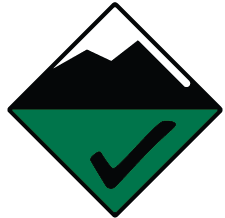
|
Generally safe avalanche conditions. Watch for unstable snow on isolated terrain features. |
Natural and human-triggered avalanches unlikely. |
Small avalanches in isolated areas or extreme terrain. |
|
|
Safe backcountry travel requires training and experience. You control your own risk by choosing where, when and how you travel. |
|||||
Before driving, manually turn the skis to the left and right to be sure ice and snow are not interfering with full left and right steering. If difficulty is encountered, remove ice and snow build-up that may be obstructing the steering linkage.
Since snow provides the only lubrication for the power slide suspension and, on liquid cooled models, cooling for the engine, adequate snow cover is a requirement for operation of your snowmobile.
If the snowmobile becomes stuck in snow, clear the running board area of snow, then step down the snow in front of the snowmobile so that when the throttle is opened, the snowmobile will be able to climb up and over the snow.
Always be aware of surroundings and terrain when riding your snowmobile. Hazardous obstructions may be hidden beneath the snow. Reduce speed and use extra caution whenever riding off established trails. Striking a hidden obstacle could cause loss of control of your vehicle and lead to severe injury or death. Remain on established trails whenever possible to reduce exposure to hazards.
When riding downhill, shift your weight to the rear of the snowmobile and reduce your speed to a minimum. Apply just enough throttle to keep the clutch engaged, allowing the engine's compression to help slow the snowmobile and keep it from rolling freely downhill.
Use extra caution when operating in hilly terrain. If climbing a hill is unavoidable, keep your weight low and forward. If you must cross the face of a slope, keep your weight on the uphill side of the snowmobile to maintain proper balance and avoid possible roll-over.
Slow down when reaching the crest of a hill. Be prepared to react to obstacles, sharp drops or other people or vehicles that may be on the other side of the hill.
If you're unable to continue up a hill, turn the snowmobile downhill before it loses momentum. If this isn't possible, spin the track just enough to dig in to prevent it from rolling back down the hill. Stop the engine and set the parking brake (if equipped). Keeping away from the downhill side of the snowmobile, pull the rear of the snowmobile around and point the front end and skis downhill. Remount the snowmobile, restart the engine, release the parking brake, and descend the hill carefully.
Do not operate the engine with the drive belt removed.
Any servicing that requires operation without a belt can be performed by your authorized POLARIS dealer.
Do not operate the engine with the intake silencer or filter removed.
Do not attempt to service the clutches.
All clutch service can be performed by your authorized POLARIS dealer. The clutch is a complex mechanism that rotates at high speeds. Each clutch is dynamically balanced before installation. Any tampering may disrupt this precision balancing and create an unstable condition.
Whenever your snowmobile has been parked for a length of time, especially overnight, always make sure the skis and track are loosened from ice and snow before attempting to drive. Apply the throttle with enough authority to put the snowmobile into motion, but always operate within safety limits.
On 2-up machines, always operate with respect for a passenger.
While much control and maneuverability is achieved through the steering system and skis, maximum control is achieved by the shifting of your body weight. Maneuverability will change based on rider weight and foot position on running boards.
Every snowmobile handles differently, and even the most docile conditions may become dangerous if operators drive improperly. If you're new to snowmobiling, acquaint yourself with the snowmobile and with what it will and won't do under various conditions. Even seasoned drivers should spend some time getting the feel for a snowmobile before attempting ambitious maneuvers.
A snowmobile depends on the rider's body position for proper balance in executing turns, traversing hills, etc. Always start on a smooth, level area to begin building your operating experience.
Before allowing someone else to use your snowmobile, know the extent of their operating skills. Check to see if they've taken a snowmobile safety course and have an operator's certificate. For their protection, as well as yours, make sure they take a snowmobile safety course. Everyone can benefit from the course.
Don't “jump” your snowmobile over large drifts or similar terrain. Jumping may injure your back because of spinal compression that could occur when the snowmobile impacts the ground. The seat and suspension of your snowmobile have been designed to provide protection under normal riding conditions. Your snowmobile is not intended for this kind of use.
Be courteous to oncoming traffic by dimming your headlights and reducing your speed.
When traveling in a group of snowmobiles, don't tailgate (follow too closely). Leave enough distance between snowmobiles to provide ample stopping room and to provide protection from flying snow and debris. Allow even more distance when driving on slippery surfaces or when driving in darkness or other low visibility conditions. Be aware of any snowmobile traffic around your vehicle. Drive defensively to avoid accidents.
Remove the key from the ignition when you leave the snowmobile unattended.
The following information is provided to help you determine when temperatures become dangerous for riding.
| Wind Speed in MPH | Actual Thermometer Reading (°F) | |||||||||||||||||
| 40 | 35 | 30 | 25 | 20 | 15 | 10 | 5 | 0 | -5 | -10 | -15 | -20 | -25 | -30 | -35 | -40 | -45 | |
| Equivalent Temperature (°F) | ||||||||||||||||||
| Calm | 40 | 35 | 30 | 25 | 20 | 15 | 10 | 5 | 0 | -5 | -10 | -15 | -20 | -25 | -30 | -35 | -40 | -45 |
| 5 | 36 | 31 | 25 | 19 | 13 | 7 | 1 | -5 | -11 | -16 | -22 | -28 | -34 | -40 | -46 | -52 | -57 | -63 |
| 10 | 34 | 27 | 21 | 15 | 9 | 3 | -4 | -10 | -16 | -22 | -28 | -35 | -41 | -47 | -53 | -59 | -66 | -72 |
| 15 | 32 | 25 | 19 | 13 | 6 | 0 | -7 | -13 | -19 | -26 | -32 | -39 | -45 | -51 | -58 | -64 | -71 | -77 |
| 20 | 30 | 24 | 17 | 11 | 4 | -2 | -9 | -15 | -22 | -29 | -35 | -42 | -48 | -55 | -61 | -68 | -74 | -81 |
| 25 | 29 | 23 | 16 | 9 | 3 | -4 | -11 | -17 | -24 | -31 | -37 | -44 | -51 | -58 | -64 | -71 | -78 | -84 |
| 30 | 28 | 22 | 15 | 8 | 1 | -5 | -12 | -19 | -26 | -33 | -39 | -46 | -53 | -60 | -67 | -73 | -80 | -87 |
| 35 | 28 | 21 | 14 | 7 | 0 | -7 | -14 | -21 | -27 | -34 | -41 | -48 | -55 | -62 | -69 | -76 | -82 | -89 |
| 40 | 27 | 20 | 13 | 6 | -1 | -8 | -15 | -22 | -29 | -36 | -43 | -50 | -57 | -64 | -71 | -78 | -84 | -91 |
| 45 | 26 | 19 | 12 | 5 | -2 | -9 | -16 | -23 | -30 | -37 | -44 | -51 | -58 | -65 | -72 | -79 | -86 | -93 |
| 50 | 26 | 19 | 12 | 4 | -3 | -10 | -17 | -24 | -31 | -38 | -45 | -52 | -60 | -67 | -74 | -81 | -88 | -95 |
| 55 | 25 | 18 | 11 | 4 | -3 | -11 | -18 | -25 | -32 | -39 | -46 | -54 | -61 | -68 | -75 | -82 | -89 | -97 |
| 60 | 25 | 17 | 10 | 3 | -4 | -11 | -19 | -26 | -33 | -40 | -48 | -55 | -62 | -69 | -76 | -84 | -91 | -98 |
| Frostbite in >> | 30 min. | 10 min. | 5 min. | |||||||||||||||
| Wind Speed in Km/h | Actual Thermometer Reading (°C) | |||||||||||||||||
| 5 | 2 | -1 | -4 | -7 | -10 | -13 | -16 | -19 | -22 | -25 | -28 | -31 | -34 | -37 | -40 | -43 | -46 | |
| Equivalent Temperature (°C) | ||||||||||||||||||
| Calm | 5 | 2 | -1 | -4 | -7 | -10 | -13 | -16 | -19 | -22 | -25 | -28 | -31 | -34 | -37 | -40 | -43 | -46 |
| 8 | 3 | 0 | -4 | -7 | -11 | -14 | -18 | -22 | -25 | -29 | -32 | -36 | -39 | -43 | -46 | -50 | -53 | -57 |
| 16 | 2 | -2 | -6 | -10 | -13 | -17 | -21 | -24 | -28 | -32 | -36 | -39 | -43 | -47 | -50 | -54 | -58 | -62 |
| 24 | 1 | -3 | -7 | -11 | -15 | -19 | -22 | -26 | -30 | -34 | -38 | -42 | -45 | -49 | -53 | -57 | -61 | -65 |
| 32 | 0 | -4 | -8 | -12 | -16 | -20 | -24 | -28 | -32 | -36 | -39 | -43 | -47 | -51 | -55 | -59 | -63 | -67 |
| 40 | -1 | -5 | -9 | -13 | -17 | -21 | -25 | -29 | -33 | -37 | -41 | -45 | -49 | -53 | -57 | -61 | -65 | -69 |
| 48 | -1 | -5 | -9 | -13 | -18 | -22 | -26 | -30 | -34 | -38 | -42 | -46 | -50 | -54 | -58 | -62 | -66 | -70 |
| 56 | -2 | -6 | -10 | -14 | -18 | -22 | -26 | -31 | -35 | -39 | -43 | -47 | -51 | -55 | -59 | -64 | -68 | -72 |
| 64 | -2 | -6 | -10 | -15 | -19 | -23 | -27 | -31 | -35 | -40 | -44 | -48 | -52 | -56 | -61 | -65 | -69 | -73 |
| 72 | -2 | -7 | -11 | -15 | -19 | -23 | -28 | -32 | -36 | -40 | -45 | -49 | -53 | -57 | -61 | -66 | -70 | -74 |
| 80 | -3 | -7 | -11 | -15 | -20 | -24 | -28 | -33 | -37 | -41 | -45 | -50 | -54 | -58 | -62 | -67 | -71 | -75 |
| 88 | -3 | -7 | -12 | -16 | -20 | -24 | -29 | -33 | -37 | -42 | -46 | -50 | -55 | -59 | -63 | -67 | -72 | -76 |
| 96 | -3 | -8 | -12 | -16 | -21 | -25 | -29 | -34 | -38 | -42 | -47 | -51 | -55 | -60 | -64 | -68 | -73 | -77 |
| Frostbite in >> | 30 min. | 10 min. | 5 min. | |||||||||||||||
Warning labels are placed on the snowmobile for your protection. Read and follow the instructions of the labels and warnings on the snowmobile carefully. If any of the labels depicted in this manual differ from the labels on your snowmobile, always read and follow the instructions of the labels on the snowmobile.
If any label becomes illegible or comes off, contact your Polaris dealer to purchase a replacement. Replacement safety labels are provided by Polaris at no charge. The part number is printed on the label.
WARNING
The Competition Only Warning label 1 is located on the right side of the dash.
This snowmobile is a competition model only and is not manufactured for, nor should it be used on public land or trails. The use of this snowmobile should be limited to participation in sanctioned competition events upon a closed course. This snowmobile should NOT be used for general off-trail recreational riding. This snowmobile is intended for experienced racers only, and NOT for beginners.

Part Number: 7178397
WARNING
The Operation Warning label is located on either side of the dash.
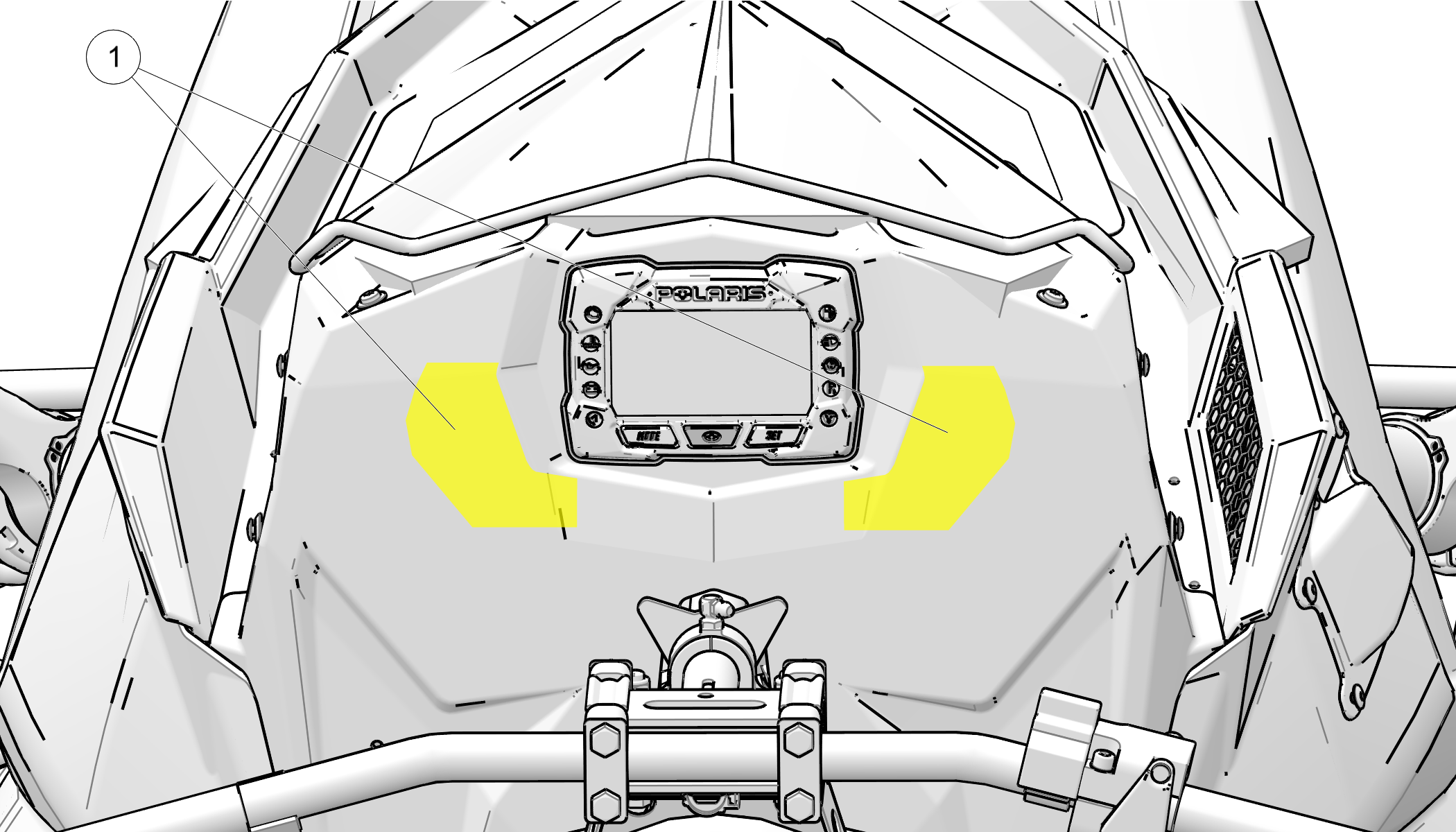
To avoid serious injury or death, read and understand all warnings and the Owner's Manual before operation. If manual is missing, contact a Polaris dealer for a replacement.
This vehicle is capable of high speeds. Buried objects or uneven terrain can cause loss of control. Reduce speed and use extreme caution when operating in unfamiliar terrain.
Excessive speed, especially at night or with limited visibility, can result in insufficient time for you to react to terrain changes, to avoid unexpected obstacles, or to stop safely.
Never consume alcohol or drugs before or while operating this vehicle.
In an emergency, push down the Auxiliary Shut-Off Switch, located on the top of the throttle control assembly, to stop the engine. Then pull the brake lever to stop.
Always wear an approved helmet, eye protection, and adequate clothing while operating this vehicle.
This vehicle is designed for adult use only. Check local laws for age requirements.
When operating with a passenger (on approved models only) reduce speed and allow extra space for steering and stopping. A passenger reduces your ability to control the vehicle.
When operating on hard-packed snow, ice, or when crossing roads, steering and braking ability are greatly reduced. Reduce speed and allow extra space to turn or stop.
To maintain vehicle control on ice or hard-packed surfaces, you should have a proper balance of ski carbides to track studs. See Owner's Manual for proper use of traction products.
Repeated stops from high speed may cause fading or sudden loss of braking ability.
Parking brake may relax when used for long periods. Do not leave brake engaged for more than five minutes.
Before starting engine, check throttle, brake, and steering for proper operation. Make sure hood and side panels are latched. Be seated and in position to control the vehicle.
Part Number: 7184133 English, 7185805 French
WARNING
The Engine and Clutch Warning label 1 is located under the engine side panel on the belt guard.
Do not operate engine with hood open.
Do not attempt adjustment with engine running.
Do not operate engine with guard open.
Never run engine with drive belt removed.
Never service clutches yourself —see your dealer.

Part Number: 7079297
WARNING
The No Passenger Warning label 1 is located on the dash below the instrument cluster.
This vehicle is designed for operator only. “NO PASSENGER”
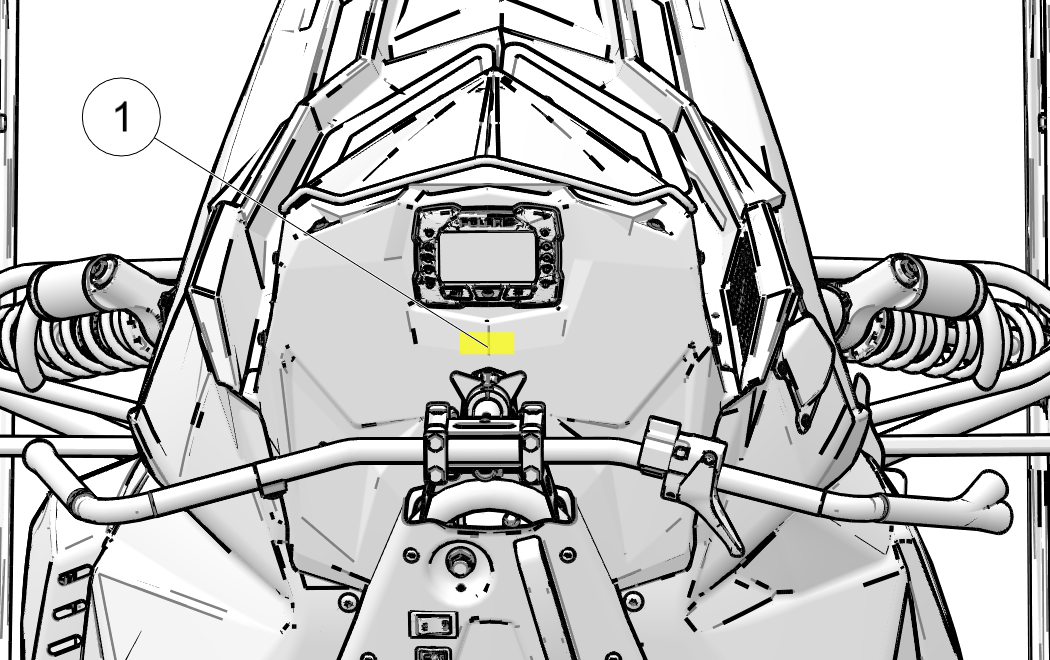
Part Number: 7172575
WARNING
The Track Warning label 1 is located on the top rear section of the tunnel.
Stay clear of track. Do not sit on seat back. Entanglement with the track or a fall from seat back may result in severe injury or death.
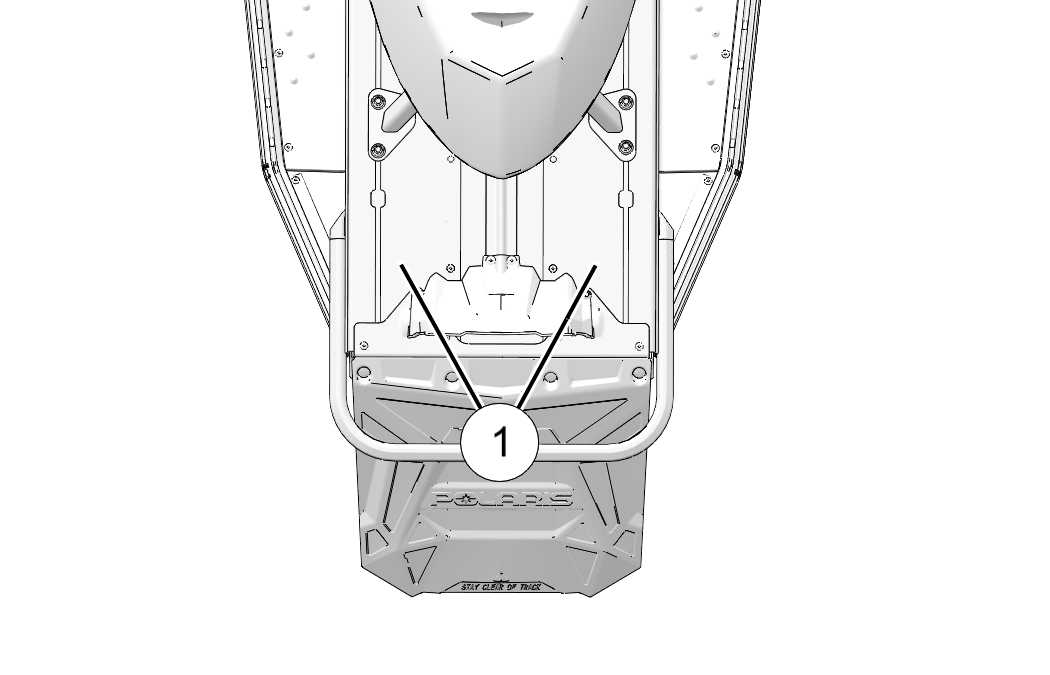
Part Number: 7172519 English, 717520 French
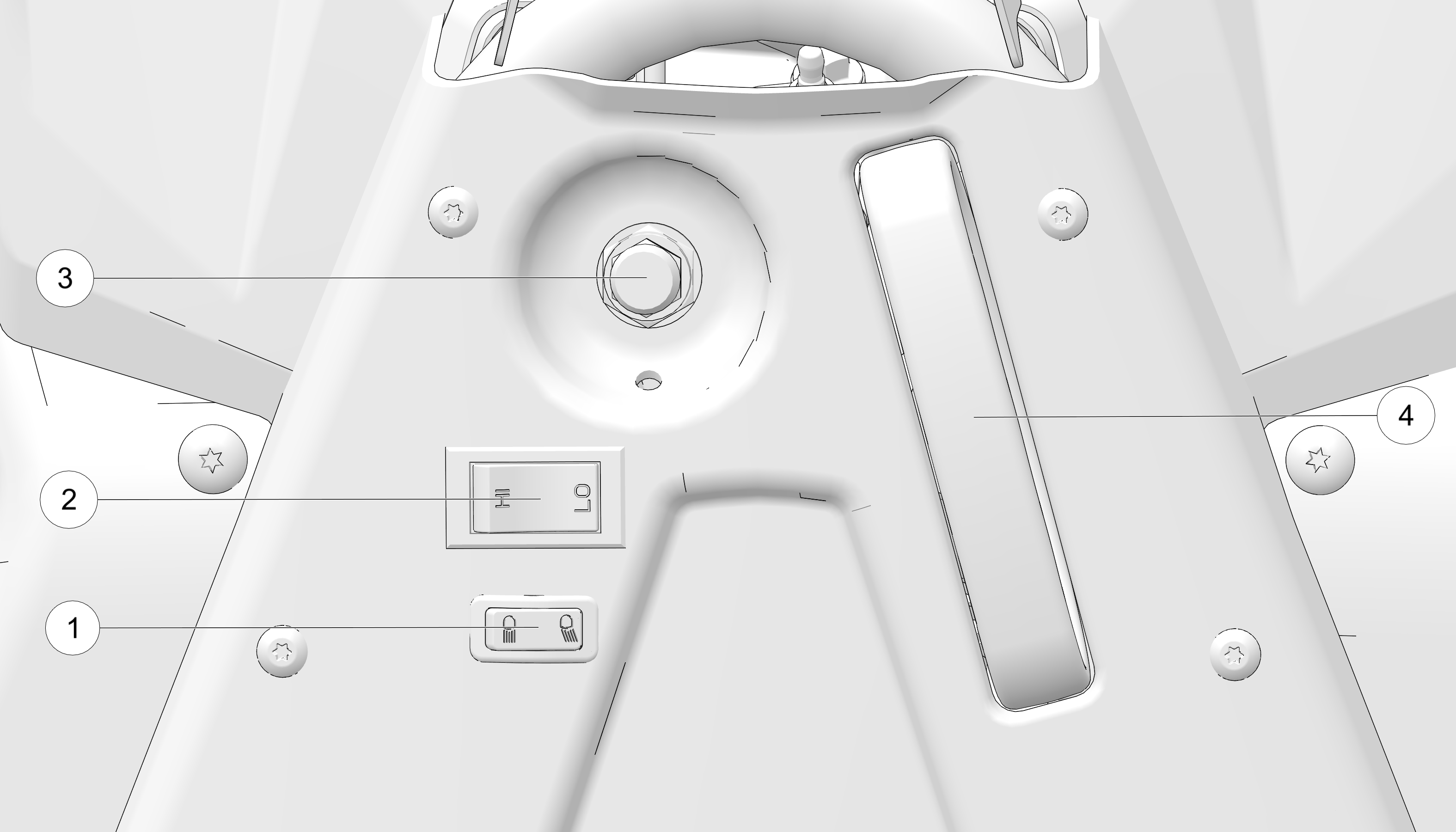
1 Headlight Switch
2 Heater Switch
3 Ignition/Tether Switch
4 Recoil Starter Handle
Your snowmobile is equipped with an ignition system feature that improves competition performance by increasing exhaust system temperature. The DRAGON Ignition System provides maximum “holeshot” performance for racing applications.
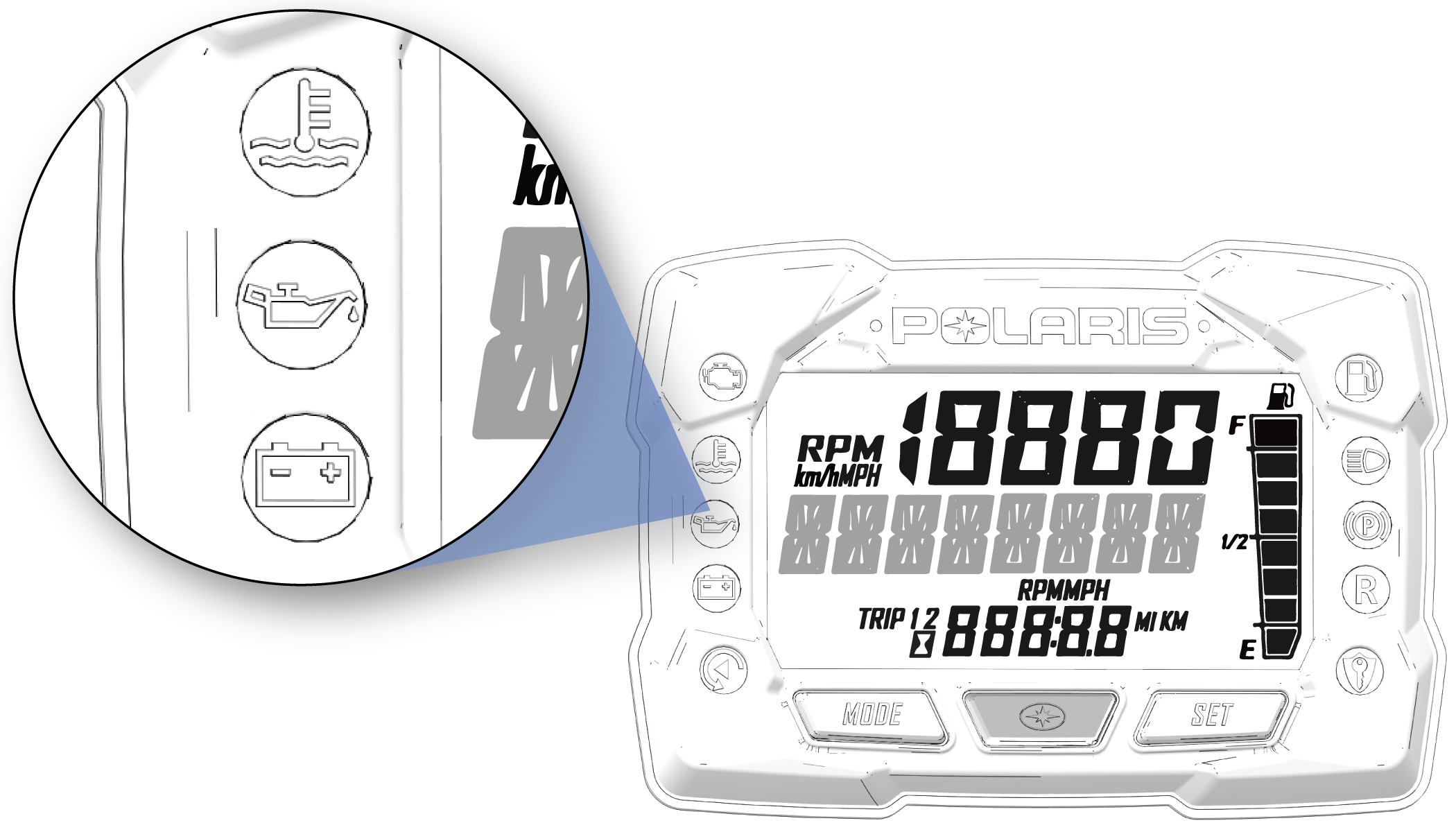
To use the POLARIS DRAGON Ignition System, do the following:
Warm up the engine and track.
When staged at the starting line, depress and hold the DRAGON button on the left handlebar.
Slowly advance the throttle to 1/8-1/4 throttle position while keeping the button depressed.
There are 3 lights that light up on the gauge to indicate pipe temperature. When all 3 lights turn off, the pipe is at optimum temperature.
Release the throttle, followed by the Dragon button.
The snowmobile is now ready for the start of the race.
The DRAGON Ignition System is intended for competition use on closed courses by experienced riders only.
There is no benefit to using DRAGON mode for normal trail riding.
Unnecessary, extended, or excessive use of DRAGON mode can result in severe engine damage, which is excluded from POLARIS warranty coverage.
Two different sounds may be heard when using DRAGON mode. One sound is an erratic misfire that may be heard when the exhaust system is heating up. The other sound is a consistent misfire (with a slight rise in engine RPM) when the exhaust system is at target operating temperature.
DRAGON mode maintains the engine speed between 4500 and 5100 RPM.
Be sure that the clutch engages at 5300 RPM or above to prevent forward creep of the vehicle. See your dealer if the clutch needs adjustment.
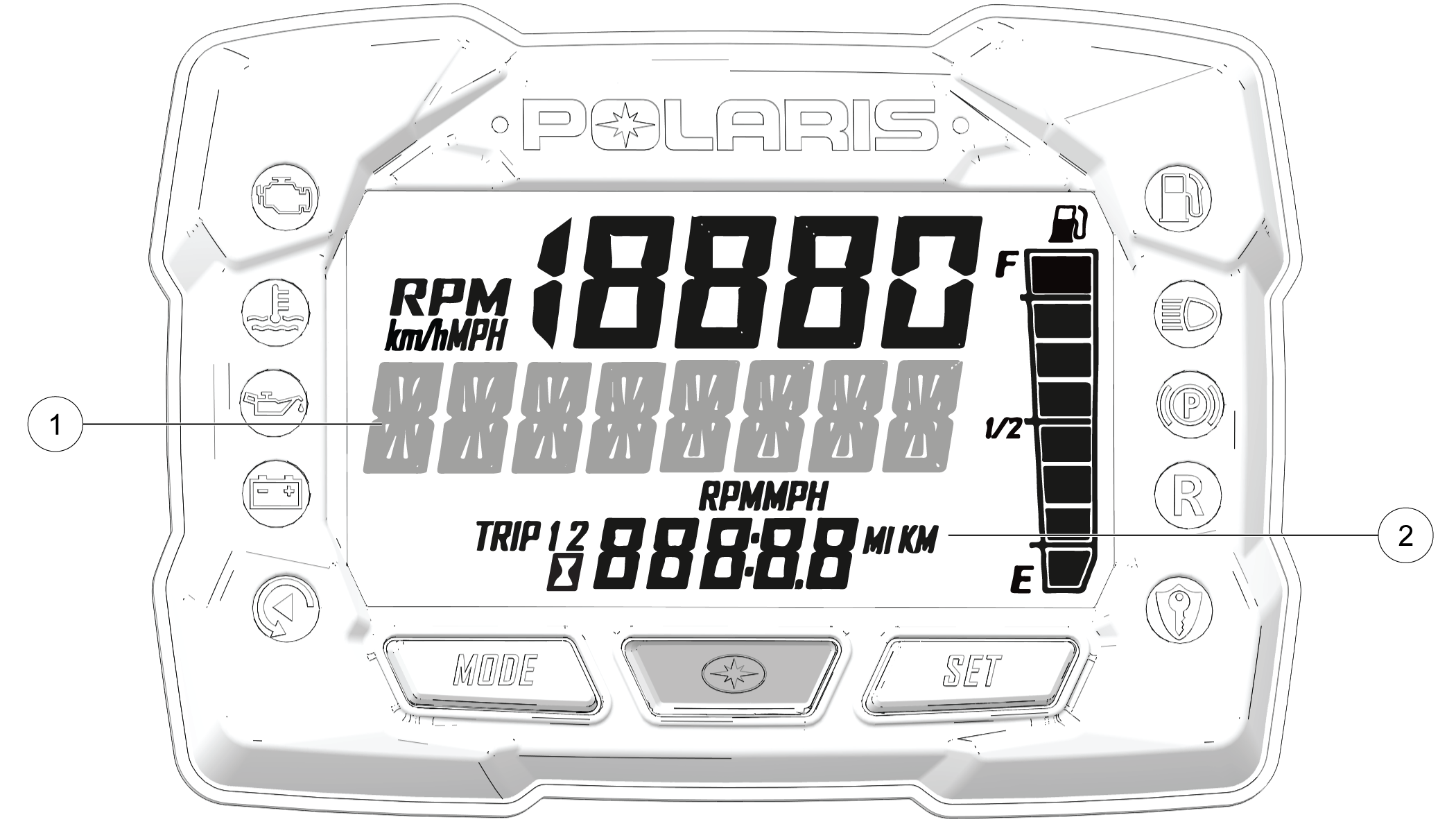
The rider information center is located in the instrument cluster. The center displays engine speed, total engine hours of operation, and clock.
Setting changes must be made with the engine running or with the vehicle powered by an external DC power supply connector.
Information Display Area - This area displays engine speed.
Engine Hour Display Area - This area displays the clock or engine hours. To change the display, see Engine Hour Display Area
.This area displays the CLOCK and Engine Hours meter.
The CLOCK displays the time, and the engine hour meter displays the total hours the engine has been in operation since manufacture.
To change the display, press and release the SET button or SET switch until the desired item is displayed.
To reset a trip meter, press and hold the SET button or SET switch until the meter resets to zero.
Break in the suspension for about 150 miles (240 km) before making any fine-tuning adjustments.
Settings will vary from rider to rider, depending on rider weight, vehicle speed, riding style, and trail conditions. We recommend starting with factory settings and then customizing each adjustment individually to suit rider preference. The machine should be methodically tested, one change at a time, under the same conditions (trail and snow conditions, vehicle speed, riding position, etc.) after each adjustment until the best ride is achieved.
DO NOT EXCEED the MIN / MAX preload values (defined by the tables in this section). Never adjust spring preload shorter than the minimum allowable length. Adjusting shorter than this length could result in damage to the suspension. Failure to comply may result in injury or damage to equipment.
Always perform shock spring preload adjustments with the weight of the vehicle removed from the shock and with the shock at full extension.
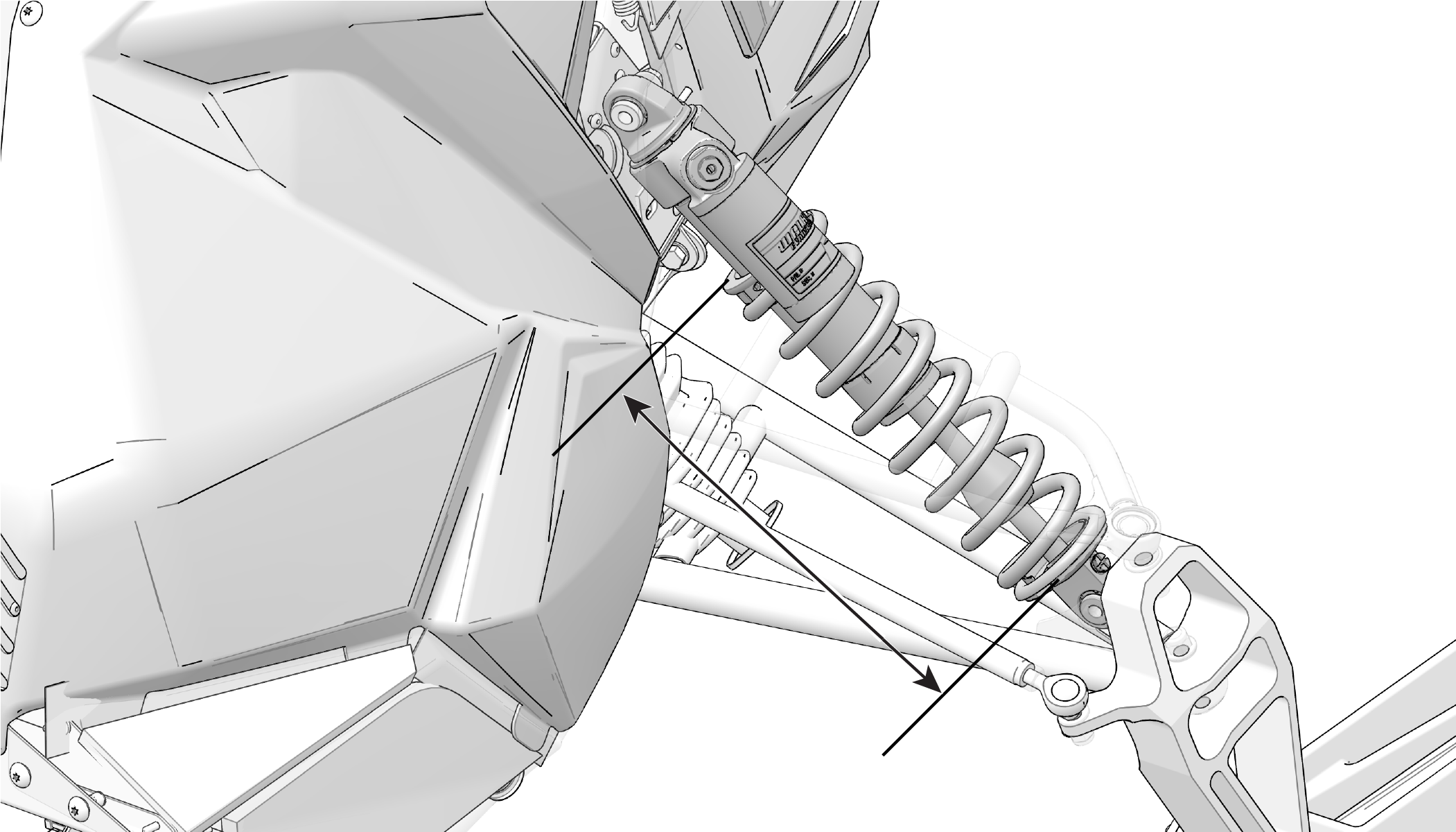
|
FACTORY SPRING |
FACTORY INSTALLED LENGTH |
MINIMUM INSTALLED LENGTH |
|---|---|---|
|
600 R |
10.5 in (26.67 cm) |
9.75 in (24.765 cm) |
The IFS shock of your Race vehicle is equipped with dual shock clickers. The clickers increase or decrease compression damping when adjusted. The inside clicker 1 adjusts shock compression during low speed compression events. The outside clicker 2 adjusts shock compression during high speed compression events. This shock also utilizes a rebound compression clicker 3 that controls how fast the shock returns to its full extended length. Use a flat-head screwdriver to adjust the rebound clicker.
To reset shock clickers, rotate the clicker to full stiff, and then back off the same number of clicks for each shock. Turn clicker clockwise to increase compression and counterclockwise to decrease compression.
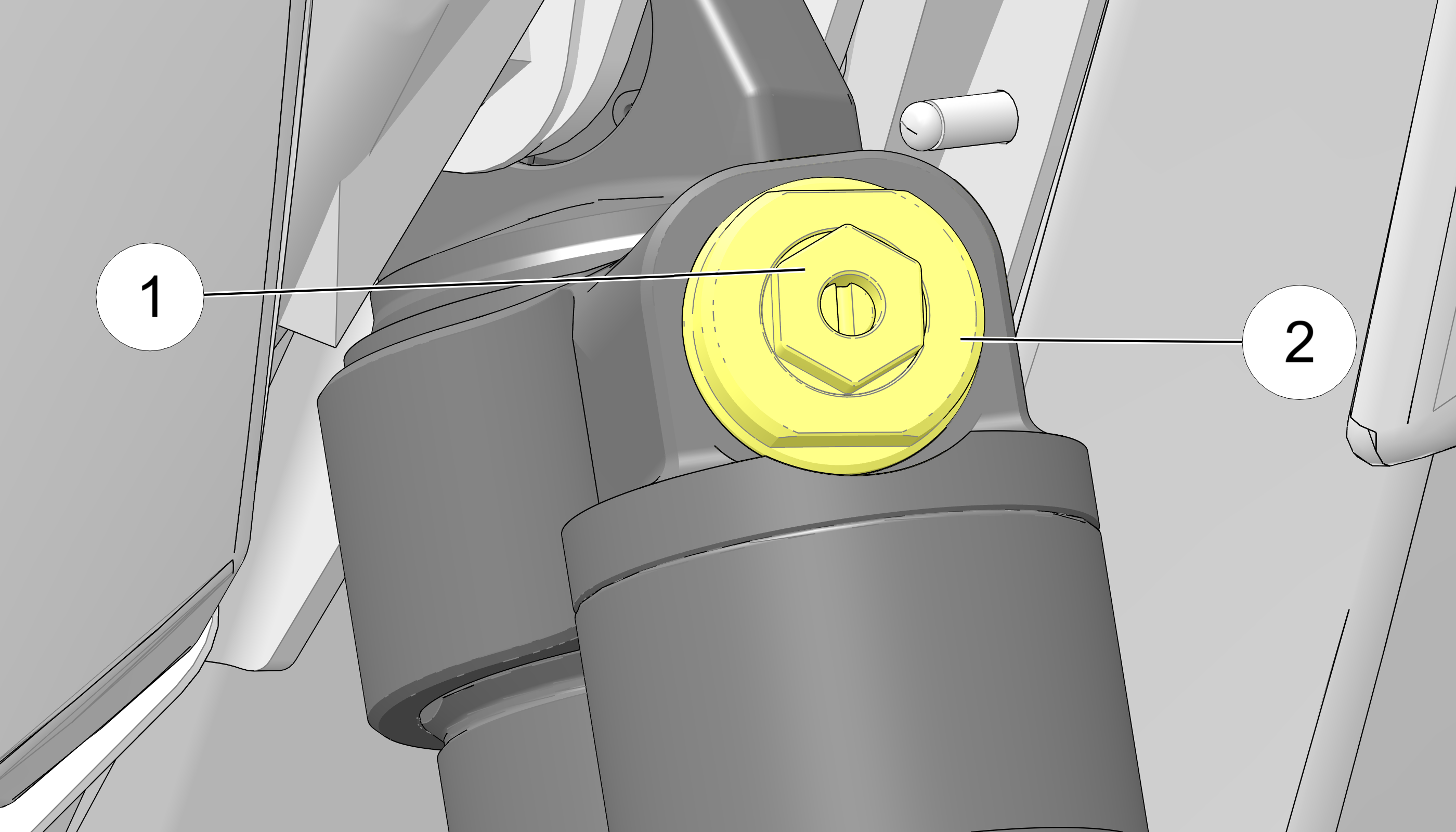

|
Model |
Clicker Setting (from full stiff) |
|---|---|
|
600 R |
Inside Clicker: 12 Outside Clicker: 16 Rebound Clicker: 6 |
Increasing spring preload will increase ski-to-ground pressure. Decreasing spring preload will decrease ski-to-ground pressure. When adjusting, be sure the springs on both the left and right sides of the machine are at the same adjustment.
To change front shock spring preload, loosen the allen bolt in the spring nut 1. Grasp the spring nut and rotate it. Torque the allen bolt to specification.
Spring Nut Allen Bolt
1.3 Nm
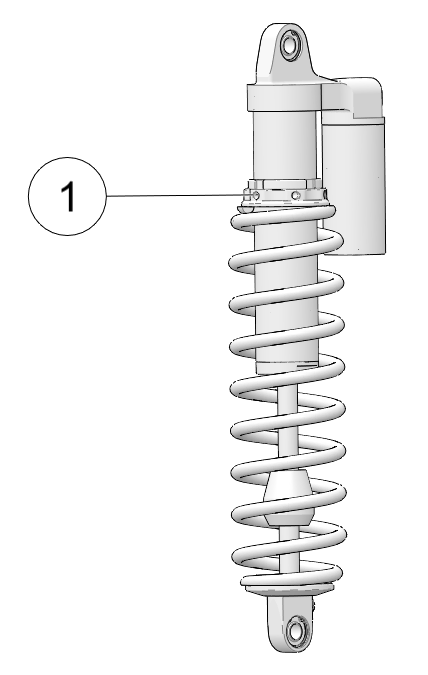
These shocks can be revalved if spring preload alone isn’t sufficient and further adjustment is desired to control suspension stiffness.
Increase the high compression damping force by turning the adjuster clockwise to increase the stiffness. Decrease the high compression damping force by turning the adjuster counter-clockwise to increase the softness. The maximum adjustment for this adjuster is the fully turned in position. The minimum adjustment is 22 clicks out from the maximum position.
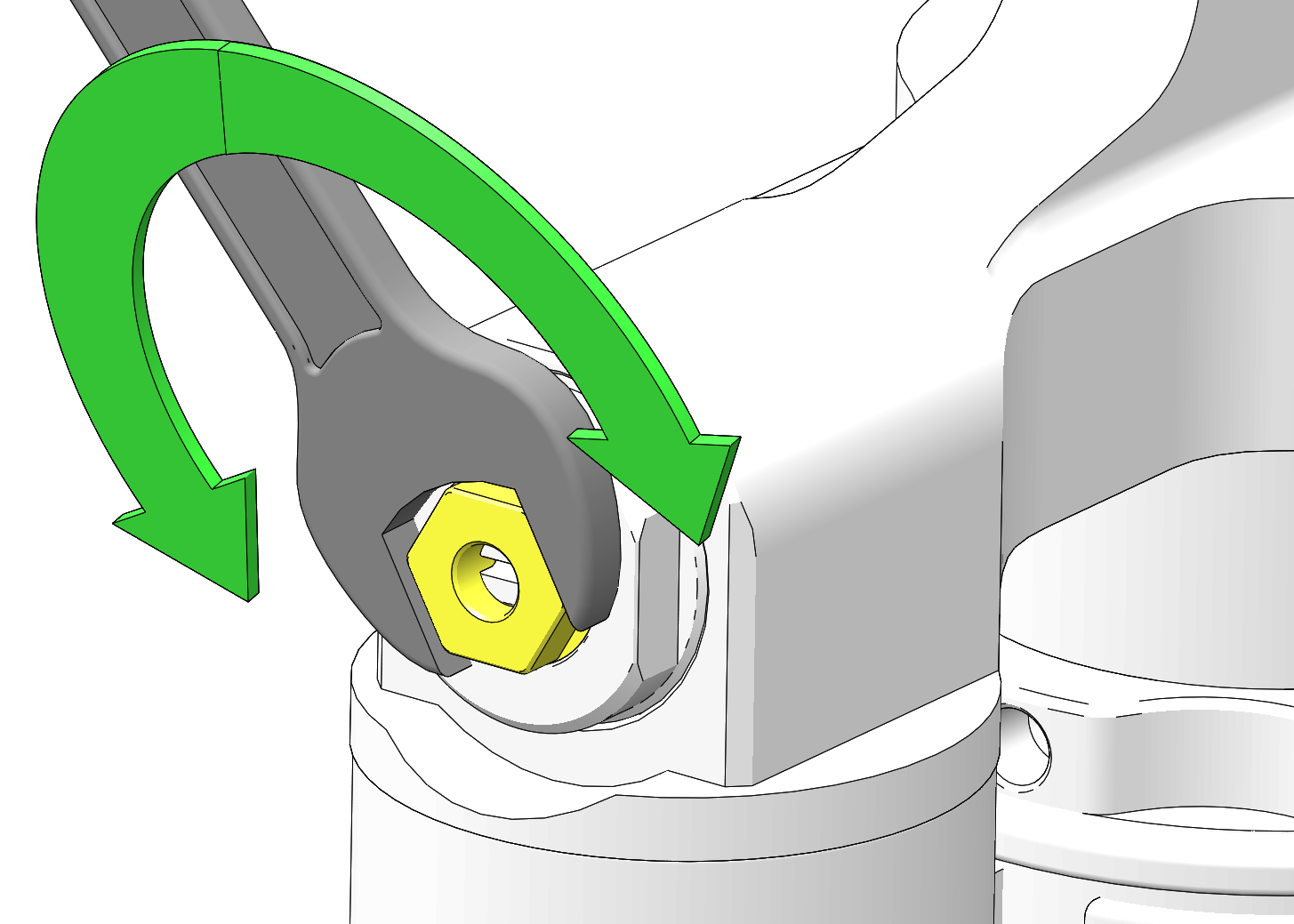
| Standard Position | |
|---|---|
| High speed adjuster | 16 clicks out from fully turned in position |
Increase the low compression damping force by turning the adjuster clockwise to increase the stiffness. Decrease the low compression damping force by turning the adjuster counter-clockwise to increase the softness. The maximum adjustment for this adjuster is the fully turned in position. The minimum adjustment is 28 clicks out from the maximum position.

| Standard Position | |
|---|---|
| Low speed adjuster | 12 clicks out from fully turned in position |
Increase the rebound damping force by turning the adjuster clockwise to increase the stiffness. Decrease the rebound damping force by turning the adjuster counter-clockwise to increase the softness. The maximum adjustment for this adjuster is the fully turned in position. The minimum adjustment is 16 clicks out from the maximum position.

| Standard Position | |
|---|---|
| Rebound adjuster | 6 clicks out from fully turned in position |
For models without externally adjustable or revalvable shocks, the front springs can be changed if the spring preload alone isn’t sufficient and further adjustment is desired to control suspension stiffness. See your POLARIS dealer for more information.
The following information is provided only as a guideline to be used for initial suspension set-up. Your set-up may vary based on your desired riding style. Rider weight, riding style, trail conditions, and vehicle speed all affect suspension action.
Each rear suspension can be adjusted to suit rider preference and deliver the best performance for a given set of conditions. However, all suspension designs and adjustments involve a compromise, or trade-off. For example, a suspension set up for snow-cross racing would provide a very stiff ride on the trail. A suspension set up for trail riding would bottom out harshly on a snow-cross course.
Make adjustments to one area at a time so you can evaluate the change. For further assistance, see your dealer.
Factory settings, combined with user adjustments to the rear track shock spring (RTSS), should be all that’s necessary to provide the best riding experience for most riders. The primary adjustment for overall vehicle balance is RTSS preload. Perform this adjustment first.
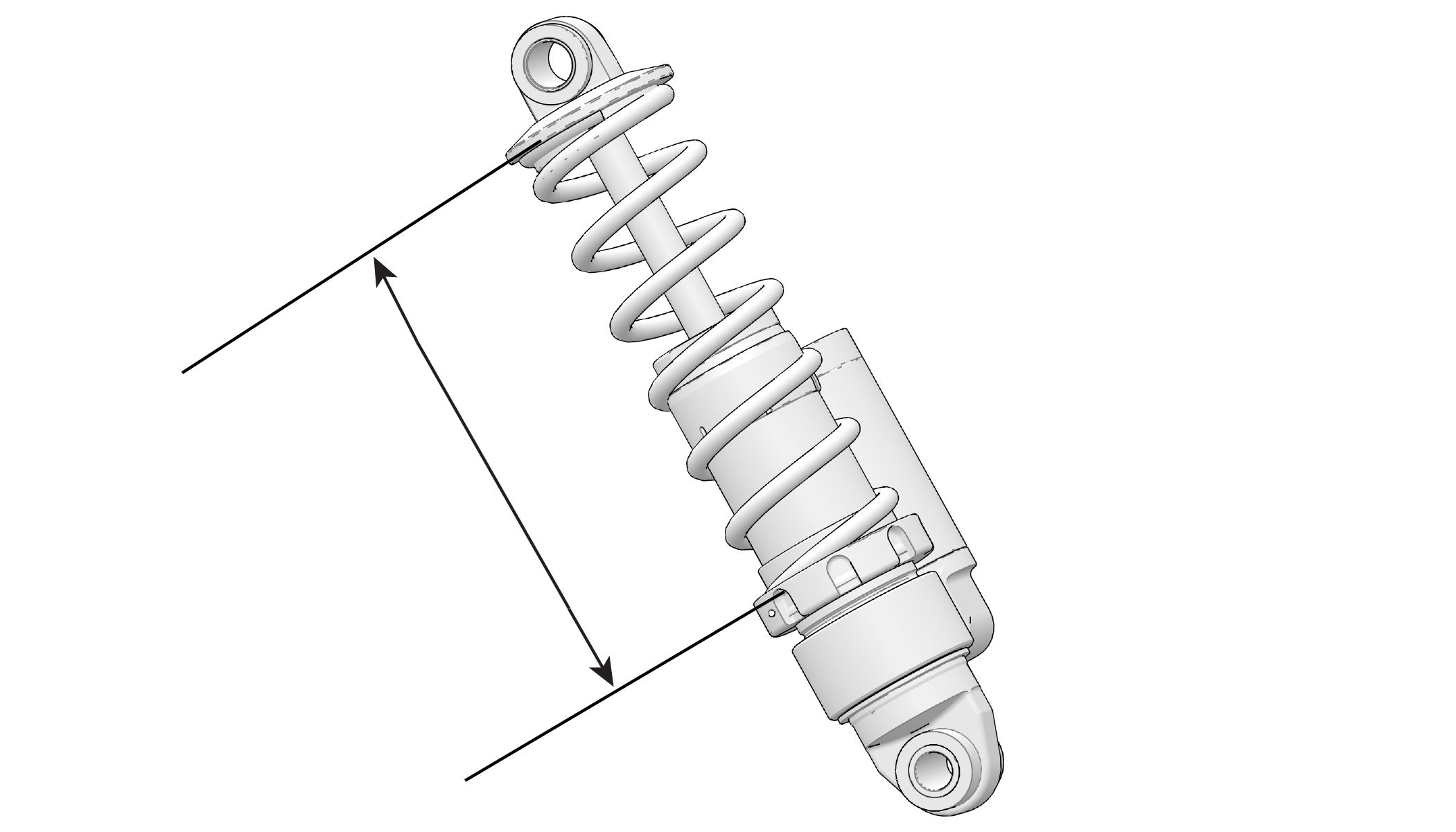
Always perform shock spring preload adjustments with the weight of the vehicle removed from the shock and with the shock at full extension.
Never adjust spring preload to an installed length longer than the factory length or shorter than the minimum length as shown in the following chart. Damage to the suspension could result. When decreasing preload, make sure at least two turns of preload are holding the retainer against the spring.
The front track shock is measured from the bottom of the spring to the top of the body cap.
|
Factory Spring |
Factory Installed Length |
Minimum Installed Length |
|---|---|---|
|
600 R |
7.375 in (18.23 cm) |
6 in (15.24 cm) |
To reset shock clickers, rotate the clicker to full stiff, and then back off the same number of clicks for each shock. Turn clicker clockwise to increase compression and counterclockwise to decrease compression.
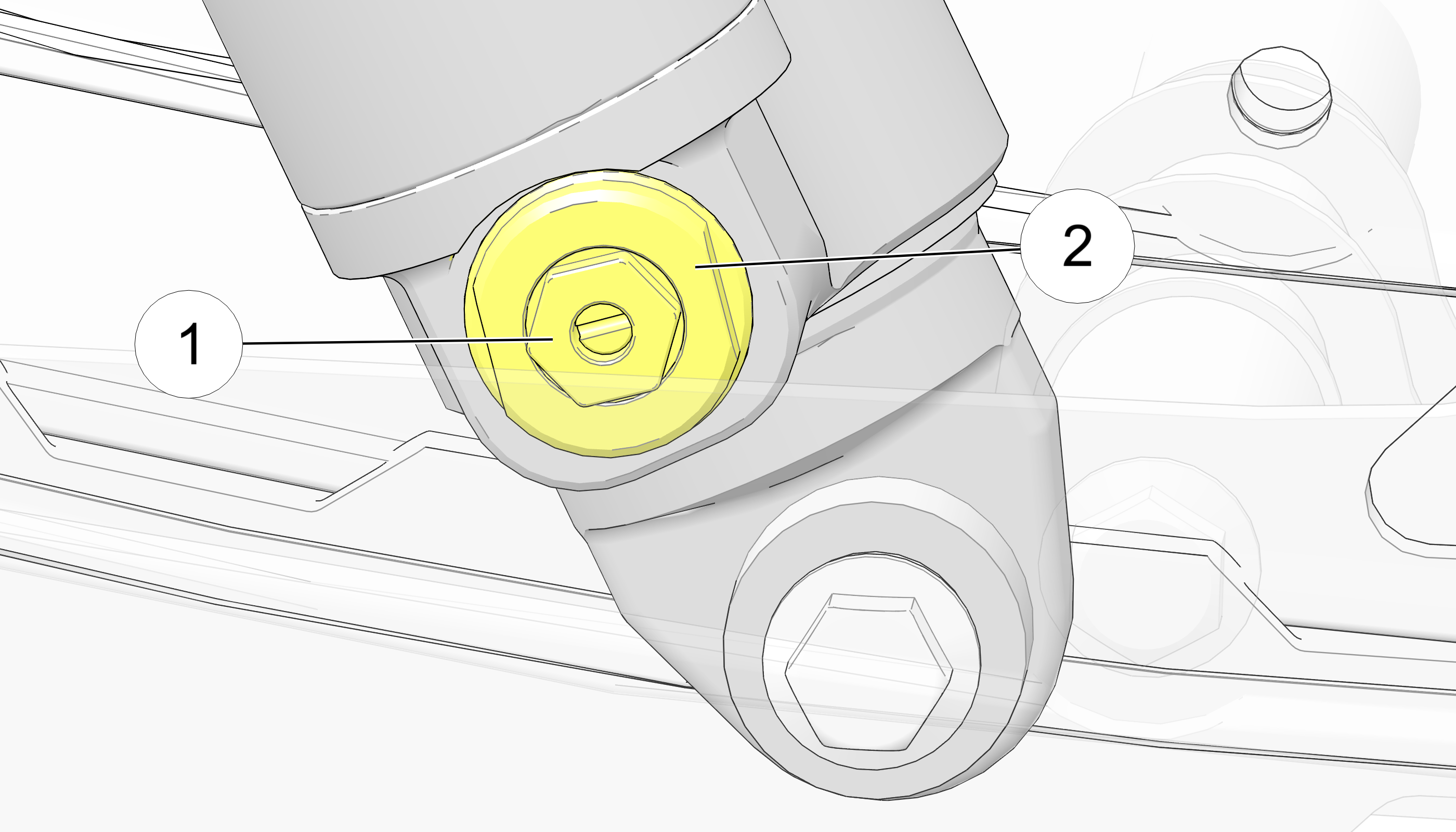
The inside clicker 1 adjusts shock compression during low speed compression events.
The outside clicker 2 adjusts shock compression during high speed compression events.
|
Model |
Clicker Setting (from full stiff) | |
|---|---|---|
|
Inside Clicker |
Outside Clicker |
|
|
600 Race |
18 |
18 |
Increase the rebound damping force by turning the adjuster clockwise to increase the stiffness. Decrease the rebound damping force by turning the adjuster counter-clockwise to increase the softness. The maximum adjustment for this adjuster is the fully turned in position. The minimum adjustment is 16 clicks out from the maximum position.
| Standard Position | |
|---|---|
| Front track rebound adjuster | 2 clicks out from fully turned in position |
Front Track Rebound Adjuster
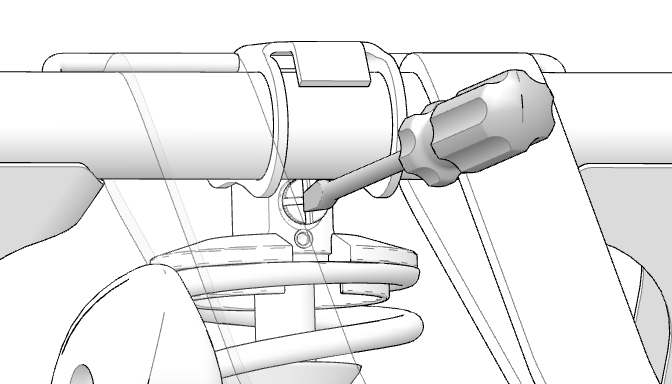
Rider weight usually determines the position at which the spring preload should be set. However, this may vary with riding style. With a little experimentation, each rider can find a preferred setup. These adjustments are easy to make, involve very little time or effort, and greatly affect the ride.
When riding on ice or hard-packed snow, adding a set of bogie wheels to the rail may enhance the machine’s performance. Bogie wheel kits are available from your dealer.
Track adjustment is critical for proper handling. Always maintain correct tension and alignment. Refer to the track tension maintenance section beginning on page 92.
To adjust the rear torsion spring, rotate the adjuster cam to the desired adjustment. The cam has three sides, LOW, MEDIUM and HIGH.
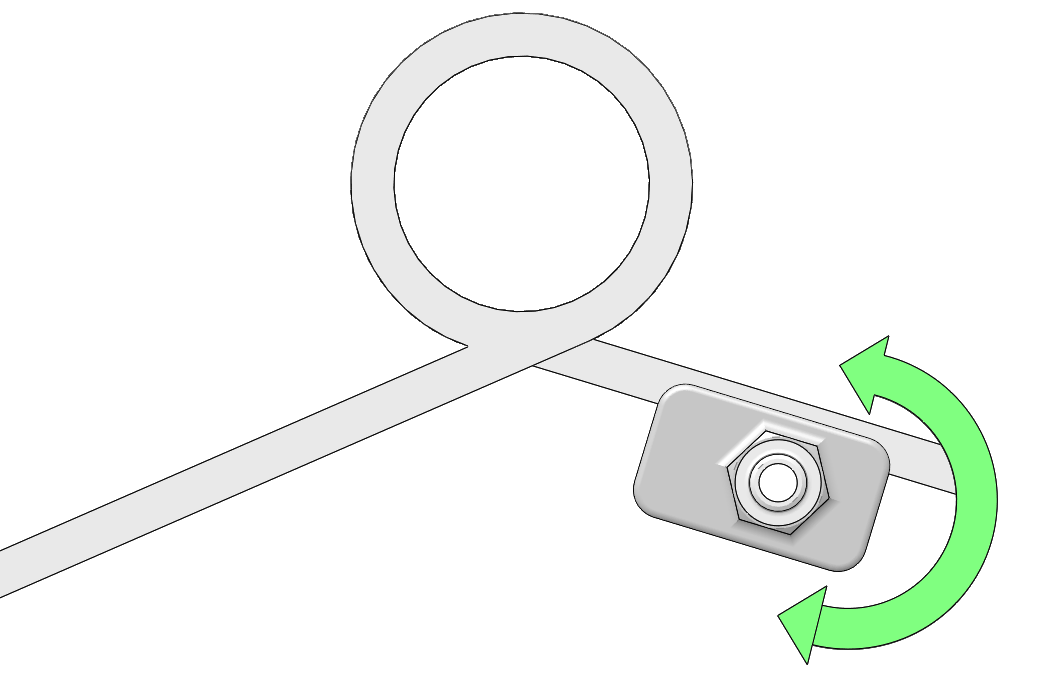
Cam shown in low position.
Torsion Spring Factory Setting: MEDIUM
One method of changing ski-to-snow pressure is to adjust the length of the front limiter straps.
Lengthening the straps decreases ski pressure under acceleration.
Shortening the straps increases ski pressure under acceleration.
The stock setting for the front torque arm limiter straps is position #3.
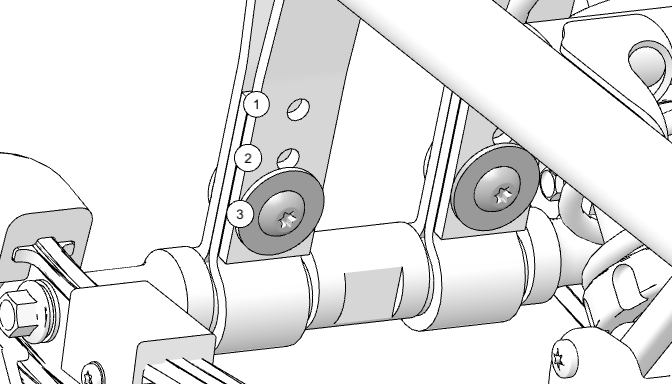
Polaris recommends leaving the limiter strap length at position #1 to maintain the optimum ride characteristics of the snowmobile.
Two features can be used to adjust the length of the limiter straps.
Install hardware in position #1, 2 or 3.
Turn the cross shaft. This feature is especially helpful when, for example, a rider wants less ski pressure than position #3 will provide but the rider wants more ski pressure than position #2 will provide.
To fine-tune the length of the limiter straps, loosen the hardware 1 that fastens the cross-shaft to the rails and then turn the shaft 2. Torque hardware to specification.
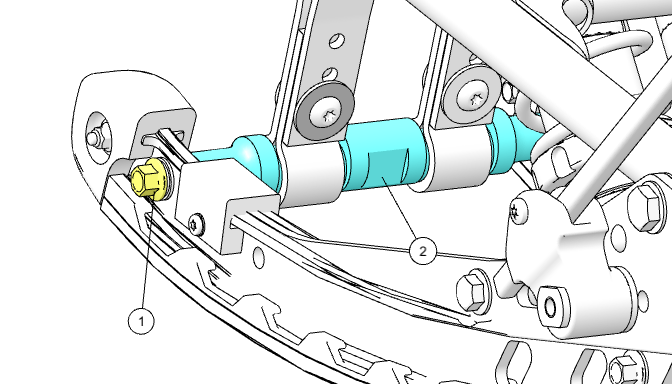
Front Cross Shaft Fastener:
33 ft-lbs (45 N·m)Increase the high compression damping force by turning the adjuster clockwise to increase the stiffness. Decrease the high compression damping force by turning the adjuster counter-clockwise to increase the softness. The maximum adjustment for this adjuster is the fully turned in position. The minimum adjustment is just 22 clicks out from the maximum position.
Rear Track Suspension

| Standard Position | |
|---|---|
| Rear Track suspension high speed adjuster | 16 clicks out from fully turned in position |
Increase the low compression damping force by turning the adjuster clockwise to increase the stiffness. Decrease the low compression damping force by turning the adjuster counter-clockwise to increase the softness. The maximum adjustment for this adjuster is the fully turned in position. The minimum adjustment is 28 clicks out from the maximum position.
Rear Track Suspension
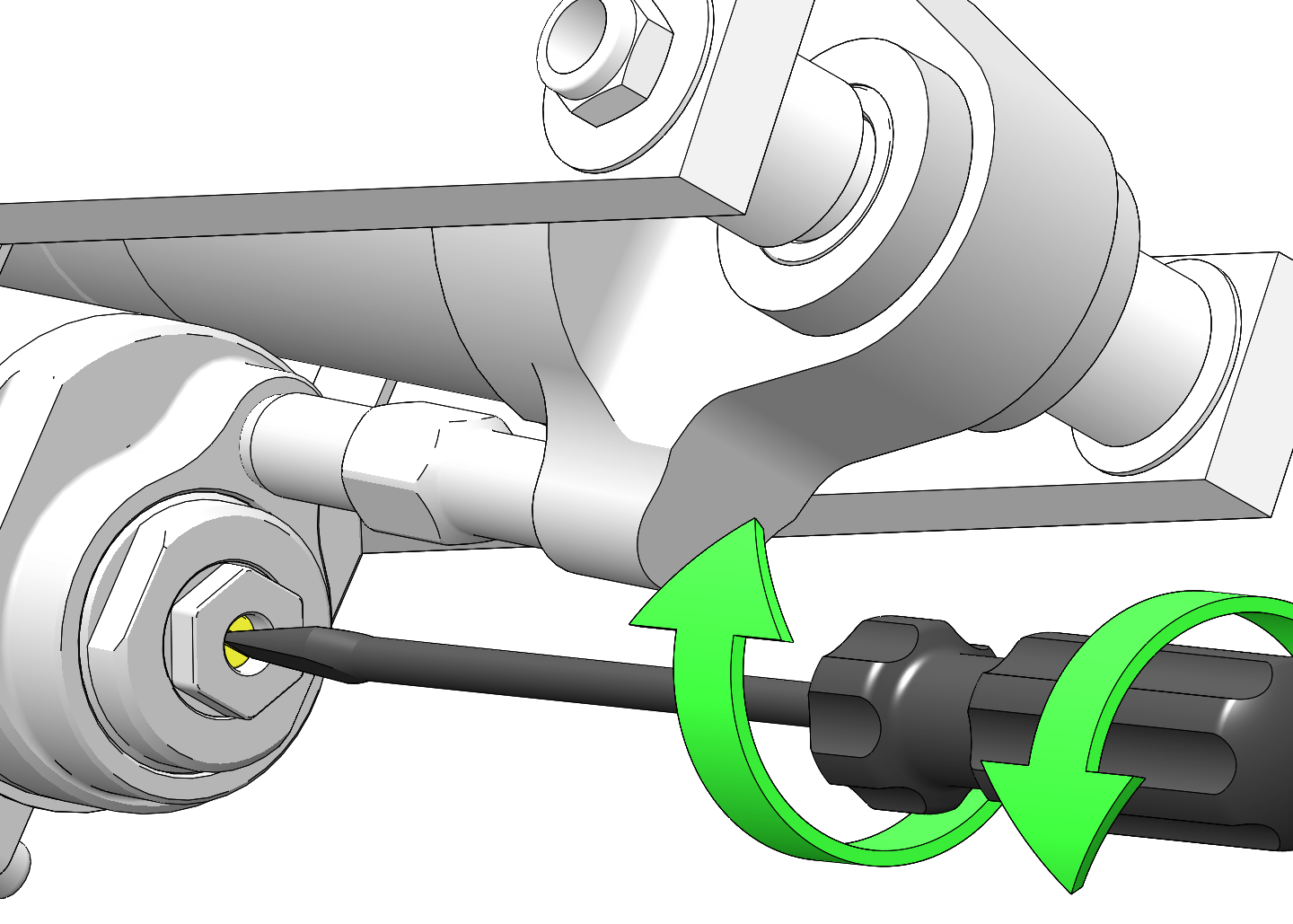
| Standard Position | |
|---|---|
| Rear Track suspension low speed adjuster | 12 clicks out from fully turned in position |
Increase the rebound damping force by turning the adjuster clockwise to increase the stiffness. Decrease the rebound damping force by turning the adjuster counter-clockwise to increase the softness. The maximum adjustment for this adjuster is the fully turned in position. The minimum adjustment is 16 clicks out from the maximum position.

| Standard Position | |
|---|---|
| Rear track rebound adjuster | 4 clicks out from fully turned in position |
On all POLARIS snowmobile rear suspensions, there are two torque arms that control the movement of the rail beam. Prior to the advent of suspension coupling, these torque arms could move independently of each other. Rear suspension coupling links the movement of the front and rear torque arms to each other. There are two types of rear suspension coupling.
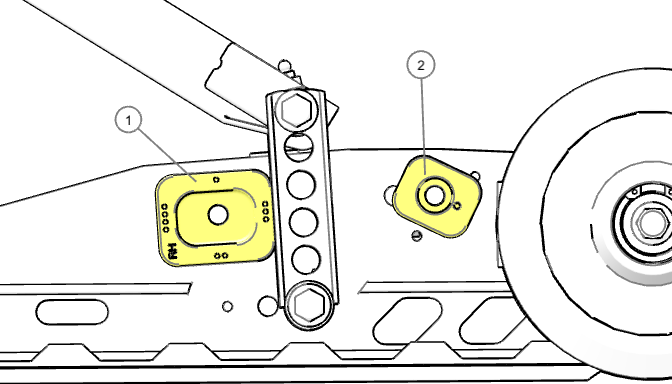
| Scissor Stop Coupling | Factory Setting |
|---|---|
| 1 Front Rear Scissor Stop (FRSS) | Setting 3 in A-HOLE |
| 2 Rear Rear Scissor Stop (RRSS) | MEDIUM in A-HOLE |
The front rear scissor stop (FRSS) controls the bump attitude of the rear suspension. As the front torque arm (FTA) hits the bump, it forces the rear scissor to collapse a predetermined amount, depending on the FRSS block position. This accomplishes two important things. First, it allows a lighter spring rate on the FTA because it can borrow spring rate from the rear torsion springs. Second, it prepares the rear portion of the suspension for the bump, reducing secondary kick back.
The FRSS is made of a resilient material allowing smooth action and preventing any suspension component damage. The RRSS controls weight transfer from the rear suspension to the skis. It also influences the stiffness of the ride by controlling the amount of coupling action between the front and rear torque arms. To decrease weight transfer, the RRSS should be set in the high position.
The RRSS can be removed for maximum weight transfer. However, unless the torsion springs and rear shock valving are changed, the ride will be compromised. Always maintain equal adjustment on both sides. The dot is an indicator of the HIGH position. The sides are the LOW position and the bottom is the MEDIUM position.
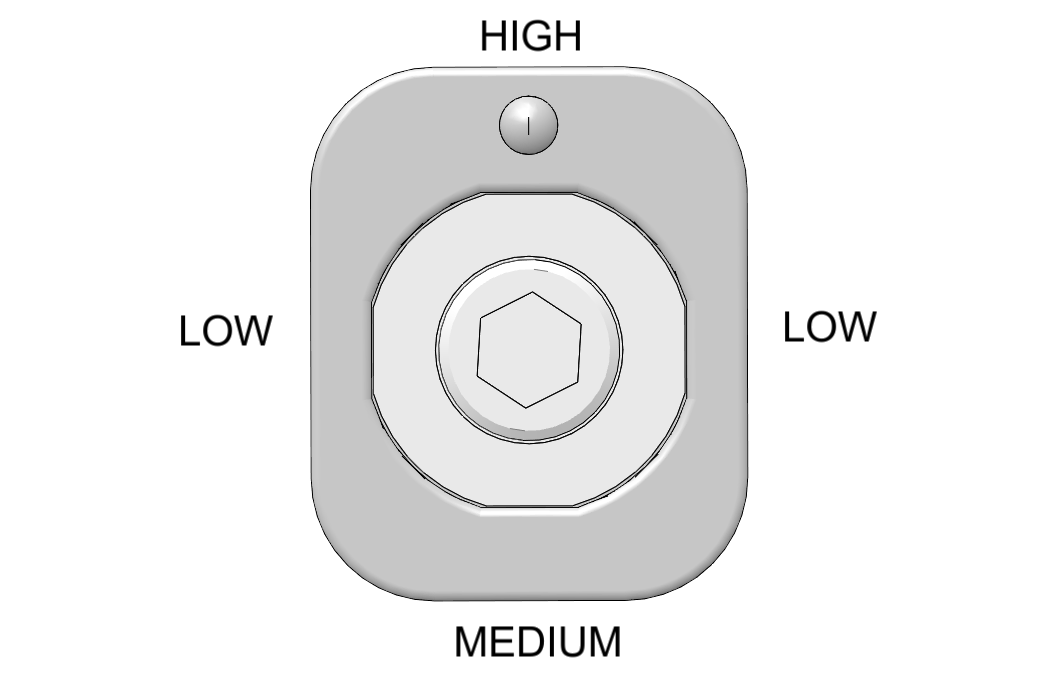
Your vehicle is equipped with a rear suspension Holeshot device 1. When activated there will be increased traction during initial acceleration.
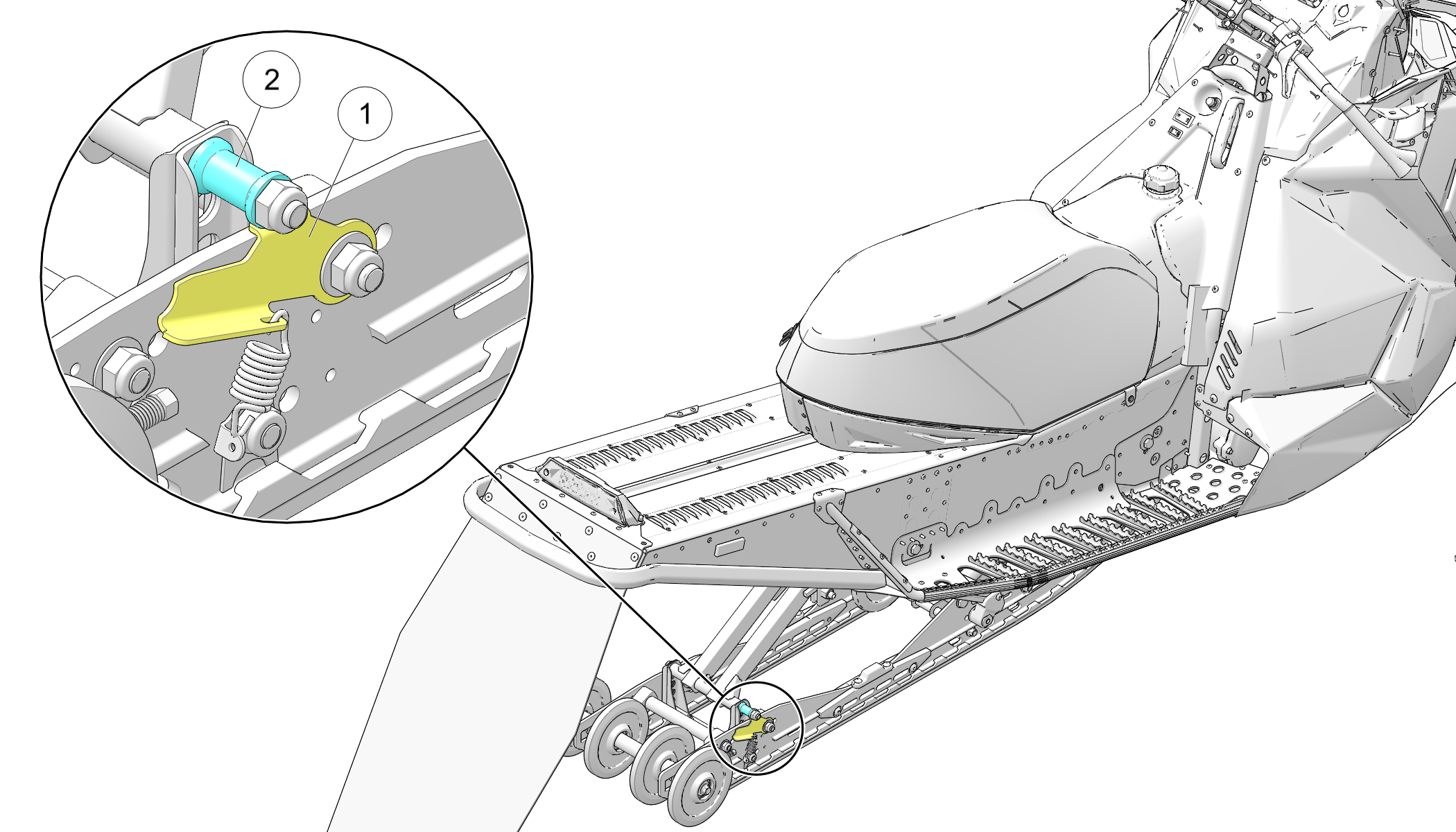
To activate the Holeshot device, compress the rear suspension of the vehicle. With the rear suspension compressed pull the device arm up until the device contacts the lower rear torque arm (RTA) extension standoff 2. The rear suspension will now stay in the compressed state until the rear suspension contacts an obstacle hard enough to compress the rear torque arm, upon which the device arm releases and rests in its inactivated state. The suspension will now operate with full travel.
|
Holeshot Device State |
|
|---|---|
|
Inactive |
|
|
Active |
|
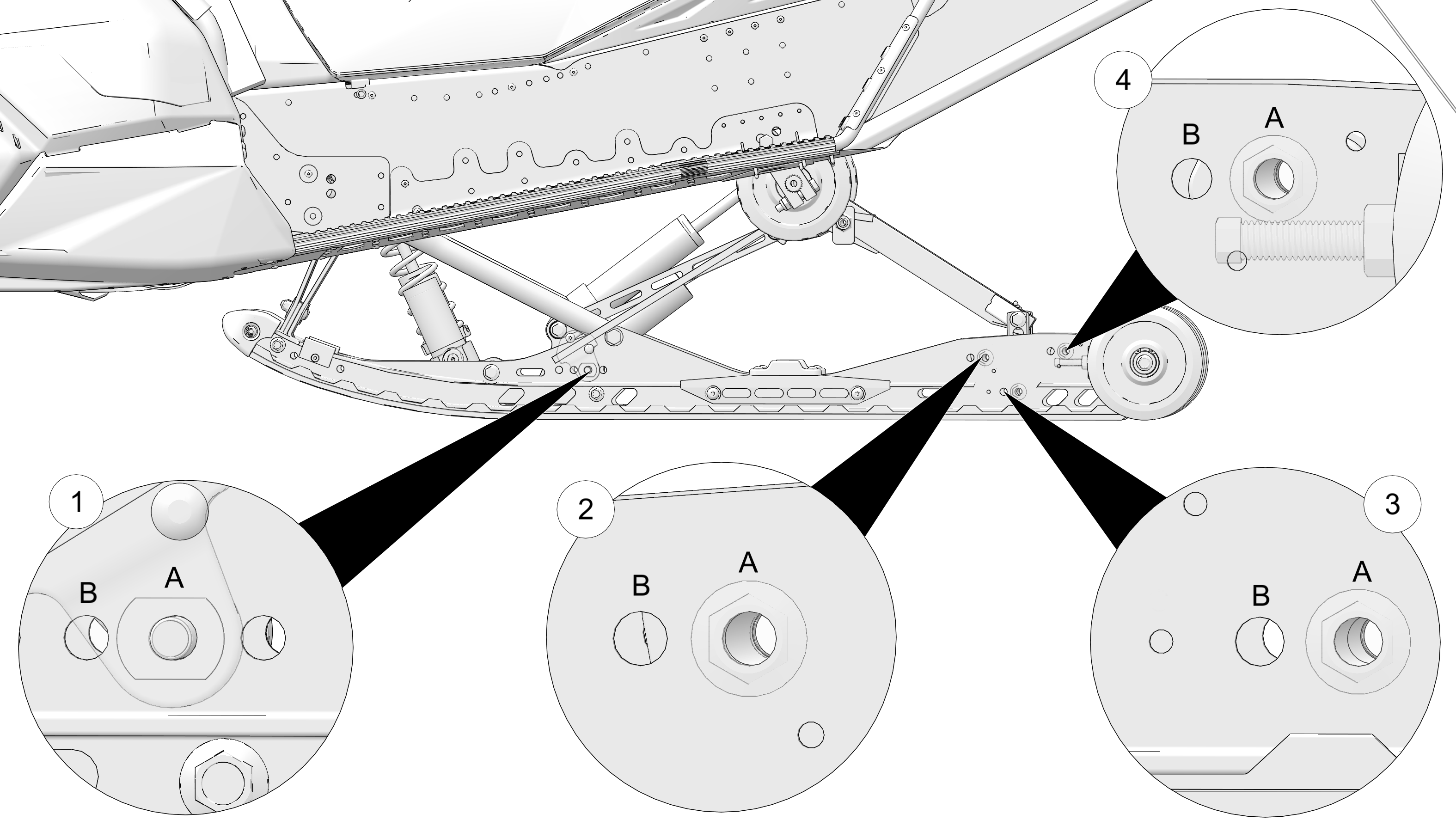
Your vehicle is equipped with optional rear suspension mounting holes. The factory installed and preferred setting is the A position. If a drastic reduction in ski pressure is desired, you can move the labeled geometry points to the B position. The 6 adjustable points are as follows:
1 Torsion Spring Hanger Hole
2 Front Coupling Block Hole
3 Lower Rear Pivot Arm Hole
4 Rear Coupling Block Hole
5 Front Tunnel Torque Arm Hole
6 Rear Tunnel Torque Arm Hole
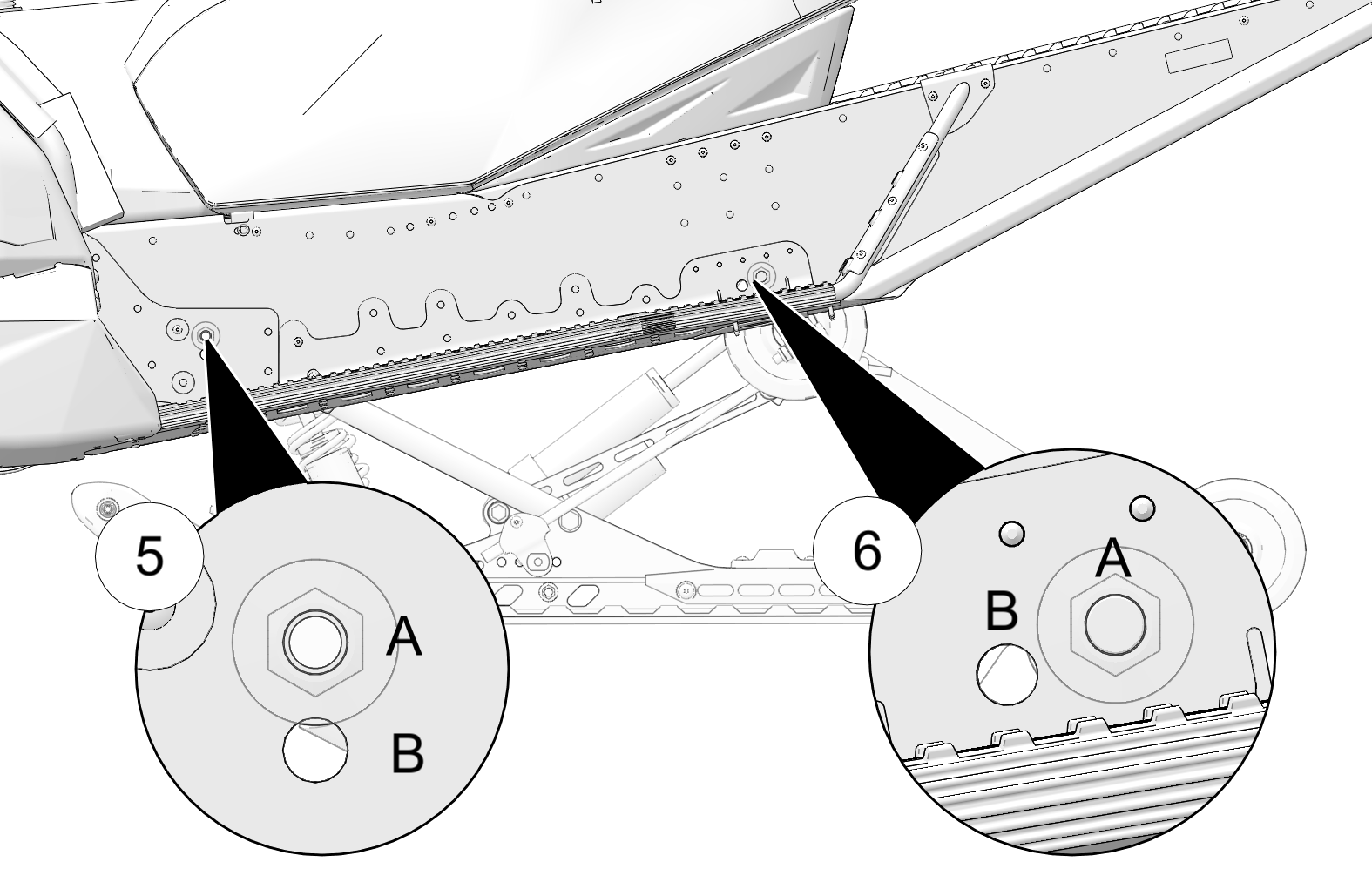
Loosen the four bottom adjuster block bolts. If necessary, pry the blocks apart with a screwdriver.
Adjust the handlebar forward or rearward to the desired position.
Tighten the bolts.
Loosen the four top adjuster block bolts. If necessary, pry the blocks apart with a screwdriver.
Adjust the handlebar forward of rearward to the desired angle. Be sure handlebars, brake lever, and throttle leber operate smoothly and do not hit the gas tank, windshield, or any other part of the machine when turned fully to the left or right.
Tighten the bolts.
POLARIS offers a wide range of accessories for your snowmobile to help make each ride more enjoyable. Use only POLARIS parts and accessories on your POLARIS snowmobile. Use of unapproved parts and accessories may result in:
Non-compliance with government/industry requirements
Voiding of warranty
Injury to self or others
This applies, but is not limited to, the following areas: brakes, clutches, fuel systems, and exhaust systems. Exhaust systems are critical safety areas that must use approved POLARIS parts. Please see your POLARIS dealer for service.
Before equipping your machine with traction products, be aware of the laws in your area pertaining to the use of traction products.
Use only POLARIS traction products on your snowmobile. Track warranties are void if track damage or failure results from improper or excessive stud installation or the use of non-POLARIS traction products.
See your dealer about installing studs and/or carbides.
Track studding will enhance braking control on hard-packed snow or ice, but extreme caution is still required on such surfaces. Steering ability may be reduced on hard-packed snow or ice.
When studded tracks are used, increased wear to the brake pads will result from increased braking. Extended-wear brake pad kits are available. See your dealer.
A skag is a replaceable bar attached to the underside of the ski to assist in turning the snowmobile and to prevent ski wear caused by contact with roads and other bare terrain. Use carbide skags with studded tracks to help maintain proper vehicle steering and control. See page 97.
If your machine has carbide skags, it may be necessary to add track studs to maintain proper vehicle control. Maintain a proper balance between the number and studs and length of carbide on the skags (the more studs you use, the longer the carbide on the skags should be). See your dealer’s track studding chart.
Inspect all items on the checklist for proper operation or condition before each use of the snowmobile. Procedures are outlined in the referenced sections.
|
Item |
See Section |
|---|---|
|
Steering System |
|
|
Recoil Rope |
|
|
Coolant Level |
|
|
Chaincase Oil Level (if equipped) |
|
|
Parking Brake Lock/Brake Lever/Brake System |
|
|
Auxiliary Shut-Off Switch (Engine Stop Switch) |
|
|
Ignition Switch |
|
|
Headlight/Taillight/Brakelight |
|
|
Skags (Wear Bars) |
|
|
Throttle Lever/Safety Switch |
|
|
Rear Wheel Idler Bolt |
|
|
Tether Switch/Strap (if equipped) |
|
|
Track Alignment/Condition |
Track and Track Alignment |
|
Rail Slide Condition |
Before starting the engine, always refer to all safety warnings pertaining to snowmobile operation. Never start the engine without checking all vehicle components to be sure of proper operation.
Read the Owner's Manual completely and refer to it often. The manual is your guide to safe and enjoyable snowmobiling experience.
The throttle and brake are the primary controls of your snowmobile. Always make sure both are functioning properly.
Squeeze the throttle lever to make sure it compresses evenly and smoothly. When released, the lever should immediately return to the idle position without binding or hesitation. If the throttle does not function smoothly, or if you discover excessive lever freeplay, DO NOT start the engine. Have the throttle serviced immediately.
Always check the following items for proper operation before starting the engine.
Squeeze the brake lever. It should move no closer to the handgrip than 1/2 inch (1.3 cm) 1. A smaller distance indicates low brake fluid level or air in the hydraulic system. Refer to the brake bleeding information on Bleeding the Hydraulic Brake System. Your dealer can assist.
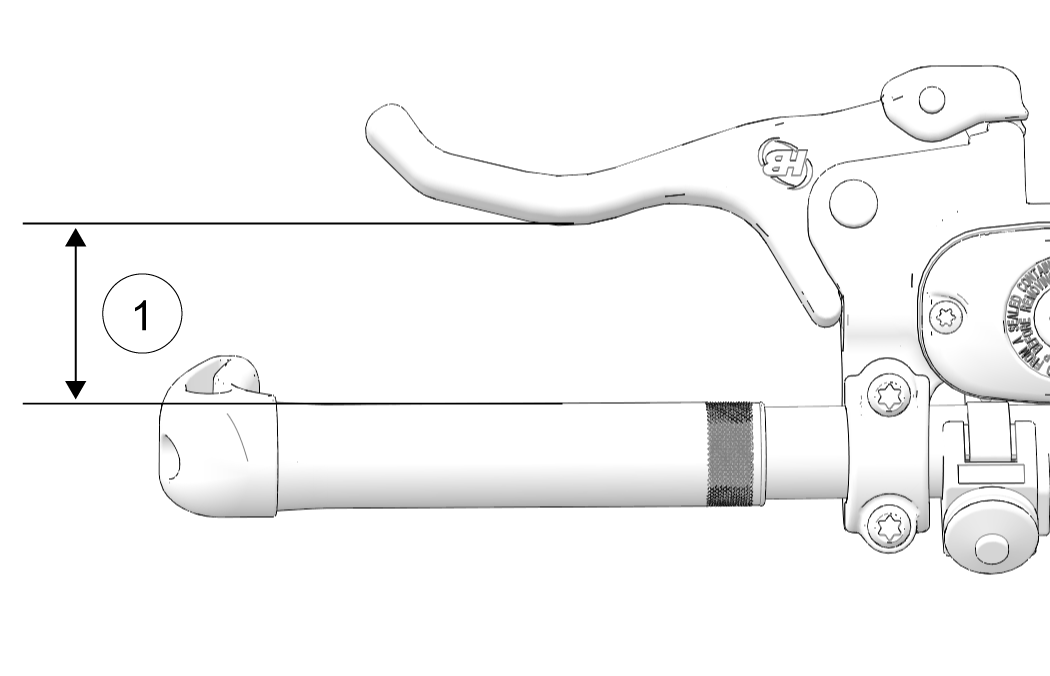
If the brake lever feels “spongy” when squeezed, check the brake fluid level and condition. Add fluid as needed. See the Brake Fluid section for details.
Replace brake fluid at least every two years with POLARIS DOT 4 high temperature brake fluid, or an equivalent product.
Use the parking brake lever lock only when you want the machine to remain stationary. For example, when parked on an incline for a period of five minutes or less.
To engage the lock, squeeze the brake lever tightly and push forward on the lock. Hold the lock forward while releasing the brake lever.
The parking brake light on the gauge will light up if the parking brake lever lock is set while the engine is running. It will also be lit when the service brake is in use. If the parking brake light does not come on when the parking brake or service brake is in use, have it serviced by your authorized POLARIS dealer.
To release the lock, squeeze the brake lever tightly. The lock will return to the unlocked position.
The steering systems on POLARIS snowmobiles can be adjusted with ski toe alignment. Improper toe alignment can cause erratic steering. Your authorized POLARIS dealer can assist with adjustments.
The hood of the snowmobile protects the operator from moving parts as well as aiding in sound emission control and other functions. Under no circumstances should your snowmobile be operated with the hood open or removed. Always ensure that the hood straps are in good condition and that the latches are securely in place before operating the snowmobile.
If your snowmobile is equipped with a removable seat, ensure that the seat is properly installed and securely latched before each use of the snowmobile.
Inspect the recoil rope and handle for excessive wear, and make sure the knot securing the rope inside the handle is secure. If excessive wear is found, your authorized POLARIS dealer can provide a replacement.
Track damage or failure caused by operation on ice or poor lubrication conditions voids the track warranty.
Before starting the engine, always refer to all safety warnings pertaining to snowmobile operation. Never engage the starter when the engine is running. Never start the engine without checking all vehicle components to be sure of proper operation. See Before Starting the Engine.
Push down on the engine stop switch 1 to ground out the ignition and stop the engine quickly. Pull the switch up to the ON position to allow restarting.
If your snowmobile has a tether switch, remove the tether from the switch to make sure the engine stops immediately.
Check the headlight (high and low beam), taillight, and brake light. Replace burned out lamps before operating.
Adjust the mirrors so they can be used to their full advantage.
Before driving away, check your surroundings. Be aware of obstacles and make sure bystanders are a safe distance from the snowmobile.
Always exercise extreme caution whenever handling gasoline.
Always refuel outdoors or in a well-ventilated area.
Always turn off the engine before refueling.
Do not overfill the tank. Do not fill the tank neck.
Do not smoke or allow open flames or sparks in or near the area where refueling is performed or where gasoline is stored.
If gasoline spills on your skin or clothing, immediately wash it off with soap and water and change clothing.
Never start the engine or let it run in an enclosed area. Engine exhaust fumes are poisonous and can cause loss of consciousness or death in a short time.
Always follow these recommended break-in procedures for new or rebuilt engines. The first tank of fuel is considered the break-in period for the engine.
Always premix the initial fuel and future fuel.
Excessive heat build-up during the first three hours of operation will damage close-fitted engine parts. Do not operate at full throttle or high speeds for extended periods during the first three hours of use. Vary the throttle openings and vehicle speeds to reduce friction on all close-fitting machined parts, allowing them to break in slowly without damage.
Drive with extra caution during the break-in period. Perform regular checks on fluid levels, lines, and all other important areas of the machine.
The only source of engine lubrication for this engine comes from lubrication added to the fuel. Always premix the fuel.
Never mix brands of oil. Serious chemical reactions can cause injection system blockage, resulting in serious engine damage. Oils may also be incompatible and the result could be sludge formation, filter blockage, and reduced cold weather flow rates.
| Recommended Oil | |
| 600 R | VES Extreme 2–Cycle Engine Oil |
Always use race specification fuel ONLY in this snowmobile. ALWAYS premix the fuel.
| Initial Tank of Fuel | ||
| Fuel | Oil | Ratio |
| 3.5 gal (13.2 l) | 16 oz (473 ml) | 28:1 |
| Future Fuel | ||
| Fuel | Oil | Ratio |
| 3.5 gal (13.2 l) | 14 oz (414 ml) | 32:1 |
If you use non-ethanol fuel (sometimes labeled “non-oxygenated”), POLARIS recommends the regular use of isopropyl-based fuel system deicer. Add 1-2 ounces per gallon (8-16 ml per liter) of gasoline to prevent damage resulting from fuel system icing. Never use deicers or additives containing methanol. POLARIS recommends the use of Carbon Clean.
The break-in period for a new drive belt is 30 miles (48 km). During this time, vary the throttle position under 50% and limit full throttle use.
New drive belts should be washed with warm, soapy water and allowed to air dry prior to use.
Always take time to warm up the belt and driveline prior to operating the snowmobile. Free the track and skis from the ground before engaging throttle.
Do not depress the throttle until the engine starts.
Attach the tether cord to the tether switch.
Pull the kill switch (shut-off switch) up to RUN.
Grasp the starter handle and pull slowly until the recoil engages then pull abruptly to start the engine.
Warm up the engine before operating.
Attach the tether cord to the tether switch.
Pull the kill switch (shut-off switch) up to RUN.
Grasp the starter handle and pull slowly until the recoil engages; then pull abruptly to start the engine.
If the engine does not start on the first pull, slightly depress the throttle with your left hand (no more than 1/4 inch open) and pull the rope with your right hand. When the engine starts, immediately release the throttle.
The following chart lists methods for stopping the snowmobile in the event of an emergency.
|
SYSTEM |
WHAT IT DOES |
THROTTLE CONDITION |
|---|---|---|
|
Brake |
Slows jackshaft |
All |
|
Engine Stop Switch |
Interrupts ignition circuit |
All |
|
Tether Switch |
Interrupts ignition circuit |
All |
Push down on the engine stop switch 1 to ground out the ignition and stop the engine quickly. Pull the switch up to the ON position to allow restarting.
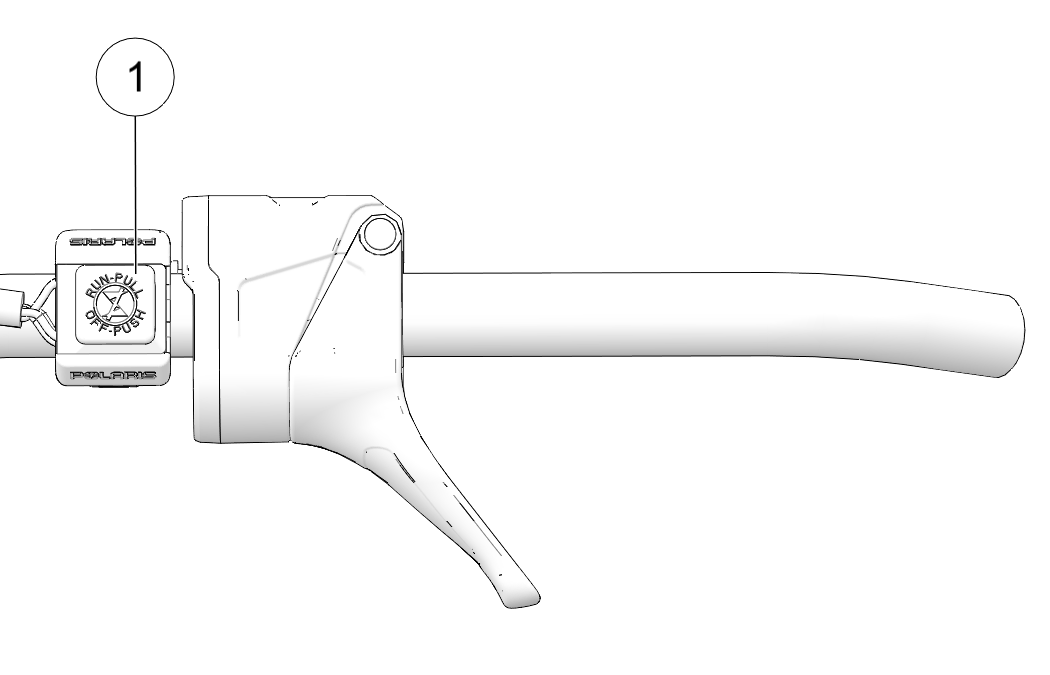
Follow these steps to ensure proper warm-up of the engine, drive train and track.
Use an appropriate stand to securely support the rear of the snowmobile at the rear bumper. The track should be about 4 inches (10 cm) off the ground.
Start the engine and allow it to warm up two to three minutes.
Depress the throttle abruptly and allow the track to rotate several revolutions.
Release the throttle, apply the brakes, shut off the engine and lower the snowmobile to the ground.
Grasp the skis by their front loops and move them from side to side to loosen snow and ice.
At the end of each ride, park the snowmobile on a level surface and support it at the rear with an appropriate track stand. The track should be suspended approximately 4 inches (10 cm) off the ground.
Cover the snowmobile with an appropriate cover.
For your safety, do not attempt to use a tow hitch until you've read the following warnings and understand the proper hitch functions.
If the snowmobile becomes inoperable and must be towed, and if it isn't possible to use a rigid tow bar, attach the tow rope to the ski spindles (not to the ski loops) to prevent damage to the steering components. Remove the drive belt before towing, and have someone ride on the towed snowmobile to operate the brake and steering when necessary.
Any qualified repair shop or qualified person may maintain, replace, or repair the emission control devices or systems on your snowmobile. An authorized POLARIS dealer can perform any service that may be necessary for your vehicle. POLARIS also recommends POLARIS parts for emissions related service, however equivalent parts may be used for such service. It is a potential violation of the Clean Air Act if a part supplied by an aftermarket parts manufacturer reduces the effectiveness of the vehicle's emission controls. Tampering with emission controls is prohibited by federal law.
Your snowmobile is equipped at the time of sale with an emission control information (ECI) label and a factory-installed emissions information hangtag. These items are required by U.S. Environmental Protection Agency regulations. The ECI label is permanently affixed to either the right side of the tunnel or the engine recoil cover. The ECI label should not be removed, even after you purchase the snowmobile. You may remove the factory-installed emissions information hangtag, which is intended solely for your use in making a purchasing decision.
Your snowmobile is certified to operate on gasoline with a minimum octane level of minimum 91 octane. If your snowmobile is equipped with a check engine light and it comes on, you must take your snowmobile to a qualified dealer for diagnostic service. Specifications and adjustments for engine tune-ups are located in the Service Manual, which is available to your qualified service technician. Reverse (if equipped) must not be engaged during engine tune-ups.
Please read the Snowmobile Engine Emissions Limited Warranty, and read the maintenance section of your owner's manual. You are responsible for ensuring that the specified maintenance is performed. POLARIS recommends that you contact an authorized POLARIS dealer, or other qualified person, to perform any service that may be necessary.
This vehicle emits some electromagnetic energy. People with active or non-active implantable medical devices (such as heart monitoring or controlling devices) should review the limitations of their device and the applicable electromagnetic standards and directives that apply to this vehicle.
To ensure many trouble-free miles of snowmobiling enjoyment, follow recommended regular maintenance and perform service checks as outlined in this manual. Record maintenance and service in the Maintenance Log beginning on Maintenance Log.
The recommended maintenance schedule on your snowmobile calls for service and maintenance inspections at 150 miles (240 km), 500 miles (800 km) and 1000 miles (1600 km). These inspections should be performed by a qualified service technician. For continued optimum performance and component life, continue maintenance checks at 1000 mile (1600 km) intervals.
All necessary replacement parts and labor incurred, with the exception of authorized warranty repairs, become the responsibility of the registered owner. If, during the course of the warranty period, part failures occur as a result of owner neglect in performing recommended regular maintenance, the cost of repairs are the responsibility of the owner.
Personal safety is critical when attempting to service or make adjustments to your snowmobile. If you're not familiar with safe service or adjustment procedures and the use of tools, or if you don't feel comfortable performing these tasks yourself, your authorized POLARIS dealer can provide any needed service.
The following chart is a guide based on average riding conditions. You may need to increase frequency based on riding conditions. When inspection reveals the need for replacement parts, always use genuine Polaris parts, available from your Polaris dealer.
I — Inspect (Clean, adjust, tighten, lubricate, replace, if necessary)
C — Clean
R — Replace
L — Lubricate
| Item | Frequency | ||||
|
150 mi. (240 km) |
500 mi (800 km) |
1000 mi (1600 km) |
2000 mi (3200 km) |
Pre-Season | |
| CLUTCH | |||||
|---|---|---|---|---|---|
| Clutch Alignment Offset (without belt) | I | I | I | ||
| Drive Belt Condition | I | I | I | I | |
| Clutches | C | C | C | ||
| Belt Tension | I | I | I | I | |
| Clutch Sheaves | I | I | I | I | |
| ENGINE/COOLING | |||||
|---|---|---|---|---|---|
| Engine Mounts | I | I | I | I | |
| Recoil Rope | I | I | I | I | |
| Engine Mounting Plate | I | I | I | ||
| Engine Torque Stop | I | I | I | I | |
| Cylinder Head Bolts | I | I | I | ||
| Cylinder Base Nuts | I | I | I | I | |
| Ignition Timing BTDC | I | I | I | ||
| VES System | C | C | C | I | |
| Coolant Level | I | I | I | I | I |
| Coolant Change | R — Every 5 years | ||||
| Coolant Hose | I | I | I | I | |
| Heat Exchangers | I | I | I | I | I |
| Coolant Circulation | I | I | I | ||
| Coolant Leaks | I | I | I | I | |
| Spark Plug Condition | I | I | I | R | I |
| Exhaust Pipe | I | I | |||
| Exhaust Retaining Springs | I | I | I | I | |
| BRAKES | |||||
|---|---|---|---|---|---|
| Hose Routing | I | I | I | I | |
| Hose Condition | I | I | I | I | |
| Fluid Leaks | I | I | I | I | |
| Brake Pads | I | I | I | I | |
| Brake Disc | I | I | I | I | |
| Parking Brakes | I | I | I | I | |
| Brake System | I | ||||
| Brake Fluid | I | ||||
| FUEL MANAGEMENT | |||||
|---|---|---|---|---|---|
| Idle RPM | I | I | I | ||
| Throttle Lever | I | I | I | I | I |
| Throttle Cable | L | L | L | ||
| Vent Lines | I | I | I | I | I |
| Throttle Position Sensor | I | I | I | ||
| Fuel Lines | I | I | I | I | I |
| Fuel Filter | I | I | |||
| Air Box | I | I | I | I | I |
| ELECTRICAL | |||||
|---|---|---|---|---|---|
| Auxiliary Shut-Off Switch | I | I | I | I | I |
| Taillight | I | I | I | I | I |
| Headlight | I | I | I | I | I |
| CHASSIS | |||||
|---|---|---|---|---|---|
| Ski Toe Alignment | I | I | I | I | |
| Suspension Mounting Bolts | I | I | I | I | I |
| Steering Fasteners | I | I | I | I | C |
| Rear Suspension Fasteners | I | I | I | I | I |
| Suspension Shock Oil | I | I | I | I | |
| Cooling Fins and Shroud | I | I | I | I | |
| Skags (Wear Bars) | I | I | I | I | I |
| Ski Saddle/Spindle Bolts | I | I | I | I | I |
| Steering Arm(s) | L | L | L | L | I |
| Upper/Lower Steering Post Support Bracket | L | L | L | L | I |
| Drive Chain Tension | I | I | I | I | I |
| Hood Latches/Straps | I | I | I | I | I |
| Rear Wheel Idler Bolts | I | I | I | I | I |
| Idler Bolt Jam Nut | I | I | I | I | I |
| Radius Rod Bushings | I | ||||
| Rear Suspension Pivot Shafts | L | L | L | ||
| Handlebar Centering | I | ||||
| Tether Switch and Strap | I | I | I | I | I |
| Track Alignment | I | I | I | I | I |
| Track Tension | I | I | I | I | I |
| Front Limiter Strap | I | I | I | I | I |
| Rail Slide Condition | I | ||||
| Chaincase Oil | I | I | I | R | I |
Lubrication points are indicated in the illustrations below.
Lubricate the steering post U-joint at the intervals outlined in the maintenance charts.
Lubricate the suspension pivot shafts with Polaris All Season Grease at the intervals outlined in the Periodic Maintenance Table and before seasonal storage. When operating in heavy, wet snow conditions, lubricate every 500 mi (800 km).
Lack of lubrication will adversely affect your ride and the life of the suspension. For more information about suspension lubrication and adjustments, see your Polaris dealer.

Lubricate the throttle cable lightly with fresh oil. With the engine
off, turn the handlebars to the left and lubricate well as shown.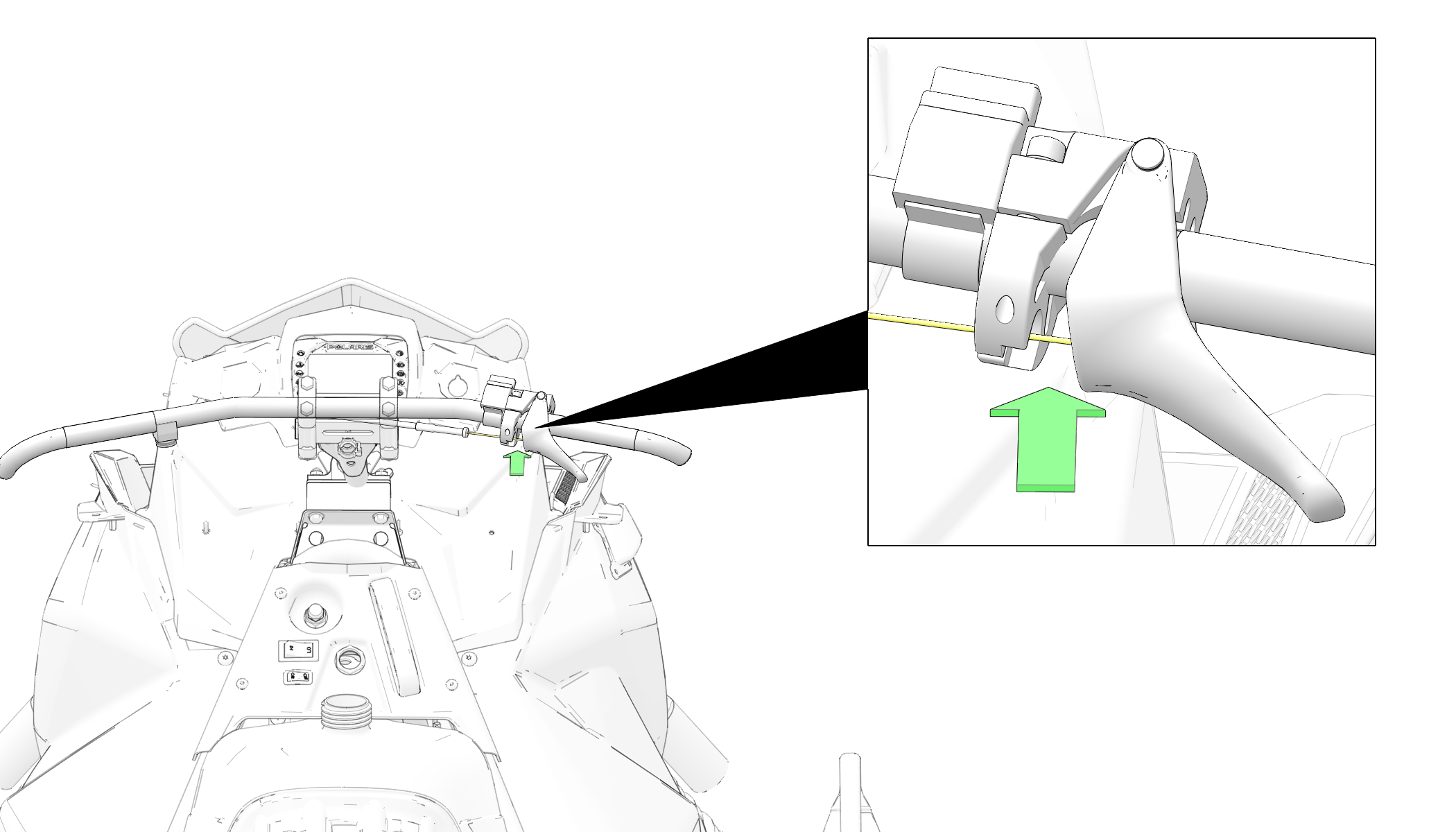


Maintain the oil level between the “safe” marks on the dipstick whenever checking or changing oil.
Position the vehicle on a level surface
Remove the dipstick 1. Verify level is in SAFE zone.
Add the recommended oil as needed. Do not overfill.
Clean the magnetic tip 2 on the dipstick.
Reinstall the dipstick.
Locate the chaincase or gearcase drain plug access hole on the bottom of the nosepan.
Place an oil catch pan under the drain plug.
Remove the drain plug and drain the oil into the catch pan.
Clean the magnetic plug to remove metal shavings.
Install drain plug and hand-tighten. Do not over-tighten the drain plug.
Fill chaincase or gearcase at the dipstick hole.
Chaincase Oil Capacity:
9oz. (266.2 ml)
Recommended Chaincase Lubricant:
Polaris Synthetic Chaincase Lubricant
The normal insulator tip is gray, tan or light brown. There will be few combustion deposits. The electrodes are not burned or eroded. This indicates the proper type and heat range for the engine and the service.
The wet fouled insulator tip is black. A damp oil film covers the firing end. There may be a carbon layer over the entire nose. Generally, the electrodes are not worn. General causes of fouling are excessive oil or use of non-recommended injection oil.
Remove the spark plug cap.
Using the special wrench provided in the tool pouch, rotate the spark plug counter-clockwise to remove.
Reverse the procedure for spark plug installation. Torque spark plug to specification.
Spark Plug:
18–22 ft-lbs (24–30 N·m)
Reinstall the spark plug cap.
The intake foam filters limit snow ingestion into the intake system. When operating in loose powder snow, check the foam filters periodically to remove any accumulation of snow.
Maintenance of the Variable Exhaust System (VES) is limited to a periodic inspection and cleaning of system components. Bring the machine to your dealer to have the VES disassembled, inspected, and cleaned at the intervals outlined in the maintenance charts.
To ensure maximum performance and minimize required maintenance, follow the oil recommendations. The use of other lubricants may cause improper function of the valve mechanism and increase the frequency of required cleaning due to excessive build-up of carbon deposits.
All fuel pump service must be performed by an authorized POLARIS dealer. Do not attempt to service the fuel pump.
This snowmobile is not equipped with an in-line fuel filter. The fuel pump uses a sock-type pickup filter located within the fuel tank. This filter should only require maintenance if debris or foreign material enters the fuel tank. An authorized POLARIS dealer can provide service.
Contaminated or poor quality fuel may shorten the life of fuel system components and result in poor engine performance. Always store fuel in clean fuel containers. If low fuel pressure or reduced engine performance occurs, the filter may need replacement. An authorized POLARIS dealer can assist.
Inspect the fuel lines regularly for signs of deterioration or damage. Always check fuel line condition after periods of storage. Normal deterioration from weather and fuel compounds may occur. Replace worn or damaged fuel lines promptly.
Kinking the fuel lines or using a pliers or similar tools to remove fuel lines may cause damage to the lines. If a fuel line has been damaged or kinked, replace it promptly.
POLARIS recommends the use of POLARIS Antifreeze 50/50 Premix. This antifreeze is already premixed and ready to use. Do not dilute with water. If the vehicle will be stored or operated at extremely low temperatures, greater protection may be required. An authorized POLARIS dealer can assist.
To ensure that the coolant maintains its ability to protect the engine, we recommend that the system be completely flushed and drained every five (5) years and fresh Antifreeze 50/50 Premix.
Any time the cooling system has been drained for maintenance or repair, replace the coolant with fresh Antifreeze 50/50 Premix.
The engine coolant level is controlled by the recovery system. The recovery system components are:
Engine filler neck
Pressure cap
Connecting hoses
Always maintain the coolant level at the top of the filler neck when the engine is cold.
Stop the engine.
Open the right side panel.
View the coolant level in the coolant bottle. Add coolant as needed.
Operating the snowmobile with insufficient coolant will result in overheating and serious engine damage. Always maintain the coolant level as recommended.
To ensure that the coolant maintains its ability to protect the engine, Polaris recommend that the system be completely drained every five (5) years and fresh Antifreeze 50/50 Premix added. This service must be performed when the engine is cold. Your authorized POLARIS dealer can check the coolant when performing the fall tune-up on your snowmobile.
Steam and hot liquids will cause burns to your skin. Never bleed the cooling system or remove the pressure cap when the engine is warm or hot.
Use of a non-standard pressure cap will not allow the recovery system to function properly. If the pressure cap needs replacement, contact your dealer for the correct part.
If coolant becomes low in the tank, bleed the system of trapped air. Perform the bleeding procedure when the engine is cold.
Allow the system to cool completely, then loosen the bleed screw and fill the reservoir to the FULL COLD mark. Tighten the screw.
Apply the parking brake and run the engine at idle RPM until the thermostat opens (5 to 8 minutes) and stays open.
Tip the snowmobile slightly onto its right side. Cycle the RPM from idle to enough RPM (4000) to get coolant to flow, but not enough to engage the clutch.
Tilt the machine slightly onto its left side so that the coolant bottle is the highest point in the cooling system. Cycle the RPM as outlined in step 3.
Return the snowmobile to its upright position and loosen the bleed screw at the top of the water outlet manifold. When all trapped air has been purged, tighten the screw.
Turn off the engine and release the parking brake. Allow the system to cool completely.
Remove the pressure cap and check the coolant level. Add coolant to fill line if necessary.
Check the exhaust system for wear or damage at approximately 1000 miles (1600 km). Always allow the engine and exhaust system to cool completely before inspecting.
Hot exhaust system parts can cause burns. Allow adequate time for the exhaust system to cool. Never perform this procedure with the engine running.
Open the side panels and remove the hood.
Inspect the muffler and pipes for cracks or damage.
Check for weak or missing retaining springs or damper/support grommets.
Check for loose clamps on the pipe covers.
Reinstall the hood and side panels.

Rotate the driven clutch counterclockwise to move all of the slack in the chain to the tensioner side. Lock the parking brake, or have an assistant hold the brake lever.
Loosen the adjuster bolt jam nut 1.
Finger tighten the adjuster bolt 2 until it can no longer be adjusted by hand, then back 1/4 turn.
Tighten the jam nut while holding the adjuster bolt. Torque specification.
Jam Nut:
23 ft-lbs (31 N·m)
Release the brake lever lock.
Inspect the brake lever reserve before each use of the snowmobile.
Brake pads must be replaced when the brake pad material becomes thinner than the backing plate (approximately 1/16 inch or 1.5 mm). A kit is available for replacing brake pads. Your POLARIS dealer can assist.
Hydraulic brakes are self-adjusting, but if excessive brake pad clearance develops, bring the snowmobile to an authorized POLARIS dealer, or other qualified person, for inspection and adjustment.
View the brake fluid level through the sight glass on the top of the master cylinder. The eye will appear dark when the fluid level is full. If the sight glass is any color other than black, add brake fluid.
Maintain the brake fluid level between the MIN and MAX marks on the master cylinder reservoir.
Replace brake fluid at least every two years.
Air in the hydraulic brake system will cause spongy brake lever action. Bleed the system before operating the snowmobile.
Operating the vehicle with a spongy brake lever can result in loss of brakes, which could cause an accident and lead to serious injury or death. Never operate the vehicle with a spongy-feeling brake lever.
Hot exhaust system parts can cause burns. Allow adequate time for the exhaust system to cool. Never perform this procedure with the engine running.
During the bleeding procedure, keep the brake handle as level as possible. The reservoir must be in this position to minimize the possibility of air entering the system through the reservoir vent.
Remove the brake master cylinder reservoir cover and gasket.
Fill the master cylinder reservoir to 1/4-5/16 inch (.6-.8 cm) below the lip of the reservoir opening. Reinstall the gasket and cover.
Slip a rubber tube over the ball of the bleeder valve and direct the flow of fluid into an approved container.
Squeeze the brake lever a full stroke. Then unscrew the bleeder valve 3/4 of a turn to release air.
Close the bleeder valve and release the brake lever.
Repeat steps 4–5 until fluid flows from the bleeder valve in a solid stream free of air bubbles.
Overfilling the master cylinder leaves no room for fluid expansion and may cause the brakes to lock, resulting in serious injury or death. Always add brake fluid to the fill line as recommended.
After bleeding is complete, refill the reservoir to the proper level. See Brake Fluid.
Reinstall the gasket and cover.
The headlight and taillight assemblies feature LED elements and are not serviceable. If an LED fails to illuminate in either the headlight or taillight, the entire assembly must be replaced.
The headlight may be adjusted for vertical aim using the following procedure.
Place the snowmobile on a level surface with the headlight approximately 25 feet (7.6 m) from a wall.
Measure the distance from the floor to the center of the headlight and make a mark on the wall.
Start the engine and turn the headlight switch to high beam.
Observe the headlight aim. The most intense part of the headlight beam should be aimed 2 inches (5.1 cm) below the mark placed on the wall.
Turn the adjustment nut, located inside the hood, just below the headlamp opening. Turn the knob in or out as needed for proper aim.
Periodically inspect clutch sheaves for damage, wear or belt residue. To maintain optimum performance, clean with non-oil based cleaners such as isopropyl alcohol.
All clutch maintenance and repairs can be performed by an authorized POLARIS dealer. Any unauthorized modifications to clutches, such as adding or removing weights, will void the warranty.
Clutch alignment offset is important for maintaining optimum performance. See your dealer for service and adjustments. A special tool is required to check for proper alignment.
Periodically check the condition and tension of the drive belt. Inspect the belt for signs of excessive wear (frayed edges, missing cogs, cracks) and excessive looseness. Replace the belt if any of these conditions exist.
Always carry a spare drive belt. Store the spare belt in the belt holder as shown. When placing the belt in the holder, orientate the belt to match the profile of the hood.
For improved drive-away during extremely cold temperatures, remove the belt and warm it to room temperature. Reinstall it before starting the snowmobile.
Measure belt deflection with both clutches at rest and in their full neutral position.
Place a straight edge on the belt and apply downward pressure while measuring at point. This measurement should be 1 1/4 inches (3.2 cm).
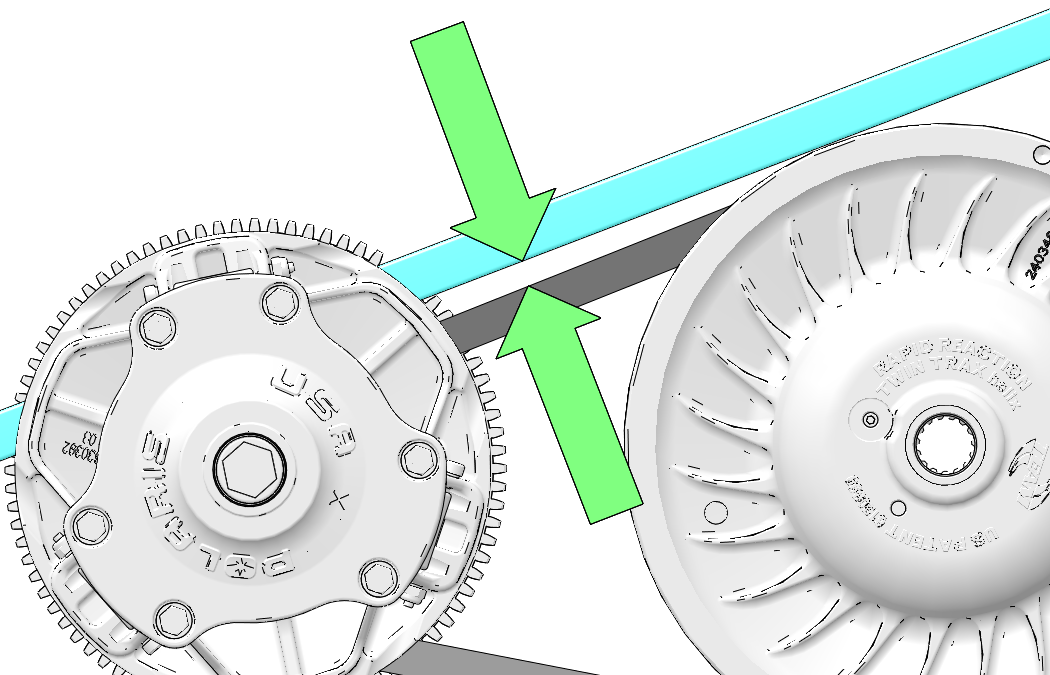
To adjust the drive belt, do the following:
Loosen the driven clutch set screw with 7/16 wrench.
Using an 1/8 in Allen® wrench, adjust set screw until belt deflection meets specification.
Holding set screw with Allen® wrench, lightly tighten nut.
Using the L-wrench, open driven clutch sheaves 0.5 in.
Tighten deflection screw nut to specification.
Deflection Screw Nut
145 in-lbs (16.4 N·m)
Rotate belt clockwise while removing L-wrench.
Do not attempt to remove the drive belt after operating in reverse. The snowmobile must be stopped after forward motion to prevent damage to components during belt removal. Rotate the driven clutch counter-clockwise 1/4 turn by hand to ensure forward engagement before attempting to remove the belt.
Stop the engine after operating in a forward motion.
Turn the ignition key off. Wait for the engine to come to a complete stop.
Lock the parking brake.
Remove the left side panel.
Rotate the driven clutch counter-clockwise 1/4 turn by hand to ensure forward engagement.
Locate the L-wrench in the tool kit. Install the wrench into the open threaded hole in the outer sheave of the clutch.
Turn the wrench clockwise until the sheaves open far enough to remove the belt. If the wrench does not turn readily, rotate the driven clutch counter-clockwise an additional 1/4 turn by hand and try again.
Remove the belt from the driven clutch.
With the L-wrench inserted into the threaded hole and the sheaves in the open position, install the drive belt.
Install the belt so that the numbers can be read correctly on the left side of the vehicle, or in the direction in which the belt was originally installed.
Rotate the belt clockwise to remove slack while removing the L-wrench.
Reinstall the side panel.
Break in the new belt. See Drive Belt Break-In.
If the snowmobile is equipped with an engine torque stop, periodically check torque stop clearance. With clutches in proper alignment, the torque stop clearance should be .010”-.030” (.25–.75 mm) from the engine case. Adjust if necessary. Lock the jam nut.
Using a hoist, safely lift and support the rear of the snowmobile off the ground.
Rotate the track by hand to check for damage.
Carefully examine the track along the entire length of each rod. Bend the track to check for breakage.
Replace the track if any rod damage is found.
The slide rail needs snow for lubrication. Excessive wear indicates insufficient lubrication. A new rail slide can cause faster heat build-up in limited lubrication, resulting in excessive wear.
If excessive rail slide wear occurs due to poor snow conditions, additional wheel kits are available. Your authorized POLARIS dealer can provide more information.
Track damage or failure caused by operation on ice or under other poor lubrication conditions will void the track warranty.
Track adjustment is critical for proper handling. Always maintain correct tension and alignment.
| TRACK TENSION DATA CHART | |||
| Suspension | Slack Measurement | Weight | Measurement Location |
| 600R | 1/2–1 in. (1.25–2.54 cm) | 10 lbs. (4.54 kg) | 16 inches (40 cm) ahead of rear idler shaft |
Turn the engine off.
Lift the rear of the machine and safely support it off the ground.
Place the recommended weight or downward pressure on the track at the specified distance (see chart) ahead of the center of the rear idler wheel.
Measure at the point where the weight is hanging.
Check for specified slack between the wear surface of the track clip and the plastic slider. Refer to the Track Tension Data Chart above.
Loosen the rear idler shaft bolt.
Loosen the locknuts.
Tighten or loosen the track adjusting screws to provide equal adjustment on both sides of the track.
Repeat the measurement on the other side of the track.
Start the machine and slowly rotate the track at least five revolutions. Let the track come to a stop (do not apply brakes).
Check track alignment and adjust as necessary.
Tighten the locknuts.
Tighten the idler shaft bolts.
Torque idler shaft bolts to 35 ft. lbs. (47.5 Nm).
Periodically check that the track is centered and running evenly on the slide rails. Misalignment will cause excessive wear to the track and slide rail.
Safely support the rear of the snowmobile with the track off the ground.
Start the engine and apply a small amount of throttle until the track turns slowly at least five complete revolutions. Stop the engine and let the track come to a stop (do not apply brakes).
Inspect track alignment by looking through the track window to make sure the rails are evenly spaced on each side. If the track runs to the left, loosen the idler shaft bolt, then loosen the left locknut and tighten the left adjusting bolt. If the track runs to the right, loosen the idler shaft bolt, then loosen the right locknut and tighten the right adjusting bolt.
After adjustments are complete, tighten the locknuts and torque the idler shaft bolt 55 ft. lbs. (75 Nm).
Repeat steps 2–3 to verify proper alignment.
The steering systems on POLARIS snowmobiles can be adjusted with ski toe alignment. Improper toe alignment can cause erratic steering. Your authorized POLARIS dealer can assist with adjustments.
Each week, or before a long ride, check all steering system fasteners and tighten if necessary.
Improper ski alignment or adjustment may cause loss of steering control, resulting in serious injury or death. Do not attempt to change the ski alignment or camber adjustment. Your POLARIS dealer can assist.
Place the handlebars in a straight-ahead position.
With only vehicle weight compressing the suspension, measure 10 inches (25.4 cm) forward from the center of the ski mounting bolt (see 3 in illustration below). At this point, measure between the skis. This is measurement 1.
Perform the same measurement rearward from the center of the ski mounting bolt. This is measurement 2.
The 1 measurement should be 1/8 inch (3 mm) greater than the 2 measurement. If the skis are misaligned, your dealer can assist with alignment correction as camber adjustment may also be affected.
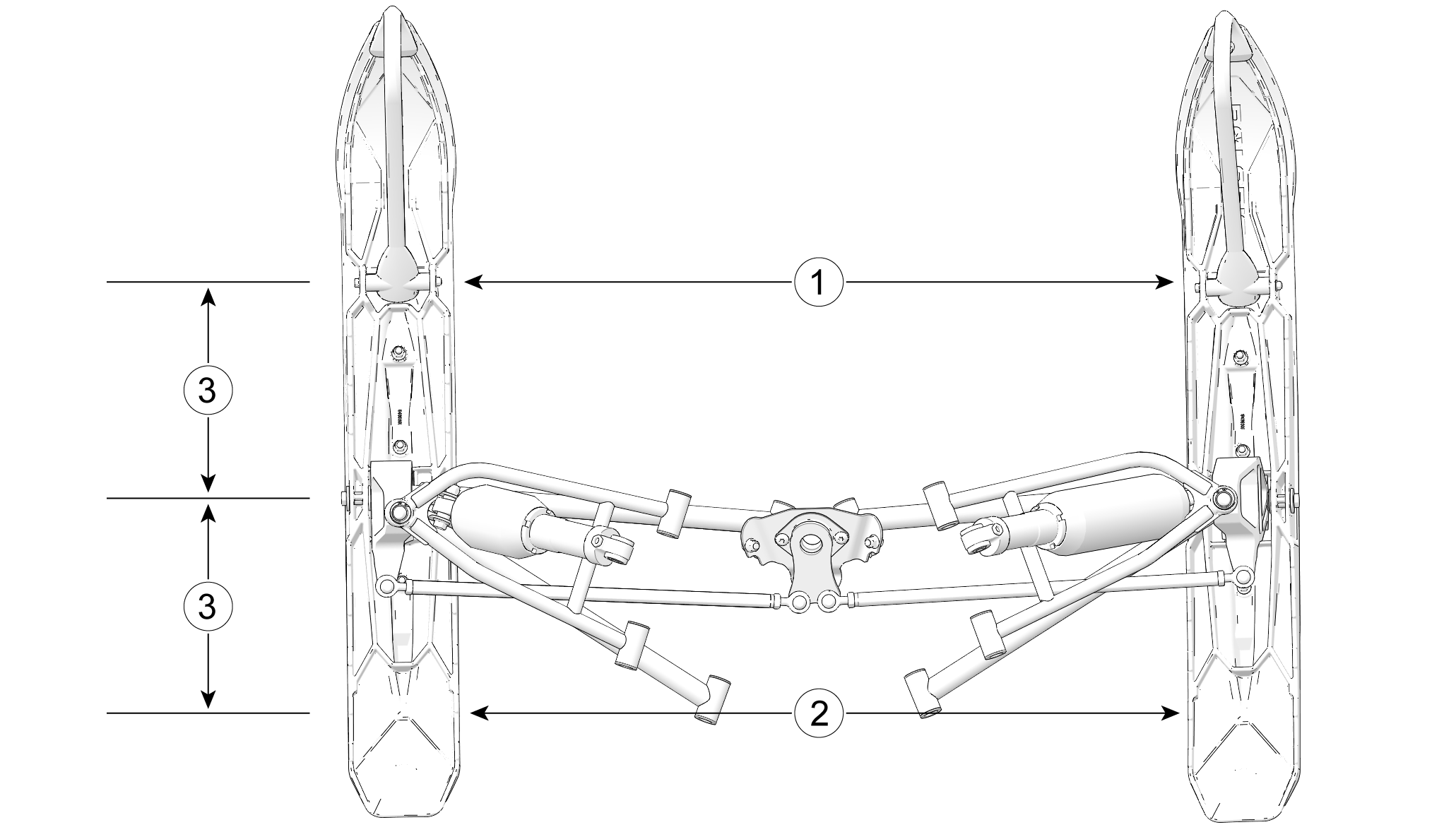
See your dealer’s studding chart for recommended skags. If you install longer or more aggressive carbide skags than the original equipment, it may also be necessary to add track studs to maintain proper vehicle control while turning on hard-packed snow or ice.
Check skags before each use of the snowmobile to ensure positive steering characteristics. Skags must be replaced when worn to half their original diameter.
Raise and support the front of the snowmobile so the skis are approximately 6 inches (15.2 cm) from the ground.
Remove the attaching nuts and pry the skag 1 downward.
Remove the front end of the skag.
Remove the rear end of the skag.
Reverse the steps to install a skag.
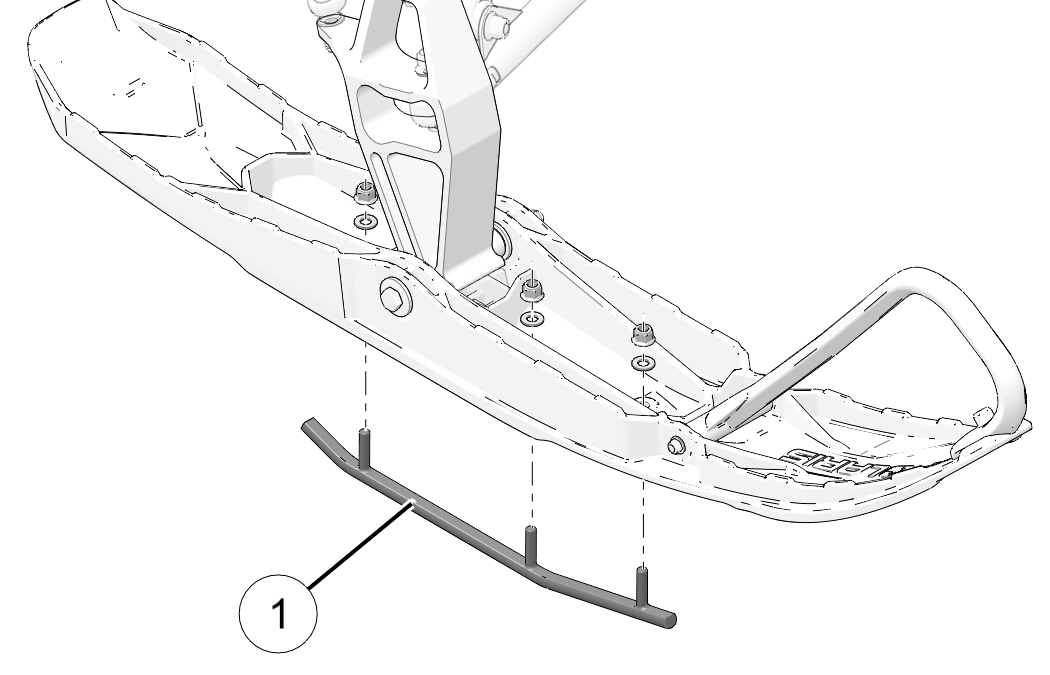
Polaris rail slides run along the bottom of the rail to prevent track wear. The rail slide should be inspected periodically and replaced when necessary.
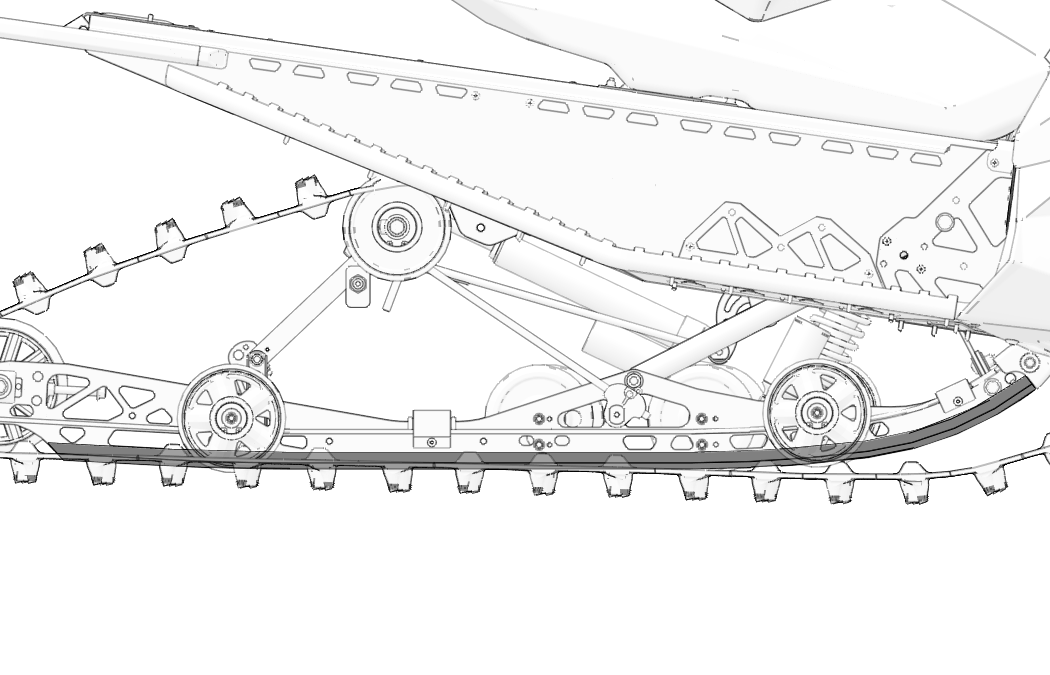
For ease of inspection, all POLARIS rail slides have a wear limit indicator groove 2 to indicate the minimum permissible slide thickness 1. Replace the rail slides if they are worn to the top of the groove at any point along their length. Failure to do so may result in permanent damage to the track or rails.
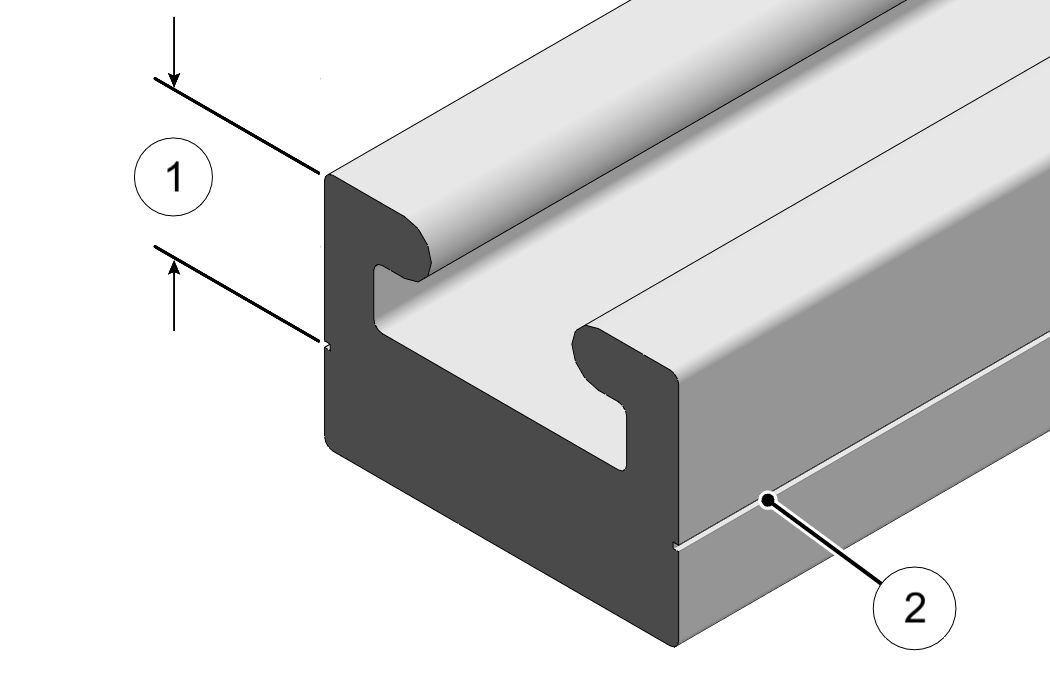
For maximum performance, your POLARIS dealer can perform a fall service tune-up. Their experienced and trained service technicians will keep your snowmobile in peak operating condition.
Off-season or extended storage of your snowmobile requires preventive measures to aid against deterioration and to prolong the useful life of many components.
Proper storage starts with cleaning, washing, and waxing the hood, side panels, chassis, and plastic parts. Wipe down remaining surfaces with a damp cloth. Clean and touch up with paint any rusted or previously painted surfaces. Be sure that corrosive salt and acids are removed from surfaces before beginning preservation with waxes and rust inhibitors (grease, oil or paint).
The snowmobile should be stored in a dry garage or shed, out of direct sunlight, and covered with a fabric snowmobile cover. Plastic tarp may cause condensation to form and damage snowmobile components.
Lubricate all bushings, tie rod ends, and cables as outlined in the Periodic Maintenance Table.
Remove the drive belt and store in a cool dry location. Do not lubricate clutch components, except the driven clutch shaft bushing as outlined in the Master Repair Manual. Your dealer can perform this service.
Proper preparation of the engine and fuel system is vital to the prevention of rust and corrosion on precision engine parts during storage. Whenever the machine is stored for a period of more than 60 days, the engine must be fogged with fogging oil. Follow the engine fogging instructions provided on the container.
Always add Carbon Clean or a fuel conditioner/stabilizer to the fuel tank. Follow the instructions on the container, running the engine for five minutes to get additives through the entire fuel system. Top off with fresh fuel. Do not allow the snowmobile to run out of fuel.
Using a fuel stabilizer and topping off the fuel tank eliminates the need to drain the fuel system. If you prefer to drain the fuel tank, use the following procedure:
Transfer unused fuel from the fuel tank to an approved fuel container using a siphon pump. Do not re-use fuel after storage.
Securely support the front of the snowmobile with a jack stand so the machine is elevated and the engine is tilted rearward.
Remove the spark plug(s).
Rotate the engine slowly, watching the piston until it’s at bottom dead center (BDC), the lowest position in the cylinder. On twin cylinder models, the opposite piston will be up.
Pour approximately two ounces of POLARIS injector oil into the spark plug hole.
Wait one to two minutes and perform steps 3–5 on remaining cylinders.
Replace the spark plugs and lower the machine to the floor.
Replace worn or frayed electrical wire and connectors. Be sure wiring harness is properly secured away from sharp edges, steering linkage, moving parts, and hot exhaust parts.
Moderate track tension should be maintained during summer storage. The snowmobile should be supported off the ground to allow the track to hang freely.
Whenever the snowmobile is transported:
Be sure the fuel cap and oil cap are installed correctly.
Tie the snowmobile to the transporting unit securely using suitable straps.
Remove the ignition key to prevent loss.
| Capacities and Dimensions | |
| Body Style | AXYS-R |
| Rider Capacity | 1 Rider |
| Coolant Capacity | 5.7 qt (5.4 l) |
| Fuel Capacity | 3.5 gal (13.2 l) |
| Oil Capacity | Premix |
| Chaincase Oil Capacity | 11 oz (325.3 ml) |
| Gearcase Oil Capacity | N/A |
| Length | 117 in (297 cm) |
| Designed Width | 43.1 in (109 cm) |
| Height | 47 in (119 cm) |
| Brake Type | Hayes® Phantom Floating |
| Drive Clutch Center Distance | 10.625 in (27 cm) |
| Drive Belt P/N | 3211208 |
| Drive Clutch Type | P-85 |
| Driven Clutch Type | Team Lightweight |
| Reverse Transmission | N/A |
| Engine and Cooling | |
| Engine Part Number | 1208838 |
| Engine | ASM-ENG S8838-6044-LA6D |
| Displacement | 599 cc |
| Cylinders | 2 |
| Bore x Stroke (mm) | 73.8x70 |
| Alternator Output | 400 watt |
| Throttle Body | 1206304 |
| Throttle Body Bore Size | (48 mm) |
| Idle RPM (+/- 200) | 1600 |
| Rated Operating RPM (+/- 200) | 8400 |
| Cooling | Liquid |
| Ignition Type | CDI |
| Ignition Timing | Variable (RPM, TPS, water temp, air temp, air pressure, exhaust temp) |
| Recommended Engine Oil | VES Extreme |
| Spark Plug/Gap | NGK® BPR 9ES/0.027 in (0.70 mm) |
| Recommended Fuel Octane | Race Specification Only |
| Clutching Chart | |||||
| ALTITUDE Meters (Feet) |
Drive Clutch Shift Weight | Drive Clutch Spring | Driven Clutch Spring | Driven Helix | Chaincase Gearing/Pitch |
| *Shaded cells indicate factory settings. | |||||
| 0-900 (0-2000) | 10-62RD (1327127) | Black 165 /
310
(7045965) |
LH 180/300 Team (7043256) | (70/44/.46) (65/42/.36) RAMPDVN LW (5142797) |
18:45 76
P
1.75 SnoCross |
| 900-1800 (3000-6000) | 10-60RD (1327129) | Black 165 / 310
(7045965) |
LH 180/300 Team (7043256) | (70/44/.46) (65/42/.36) RAMPDVN LW (5142797) |
18:45 76 P
1.75 SnoCross |
| 1800-2700 (6000-9000) | 10-58RD (1323261) | Black 165 / 310
(7045965) |
LH 180/300 Team (7043256) | (70/44/.46) (65/42/.36) RAMPDVN LW (5142797) |
18:45 76 P
1.75 SnoCross |
| 2700-3700 (9000-12000) | 10-56 (1321684) |
Black 165 / 310
(7045965) |
LH 180/300 Team (7043256) | (70/44/.46) (65/42/.36) RAMPDVN LW (5142797) |
18:45 76 P
1.75 SnoCross |
Unless you have experience and training in two-cycle engine repair, your dealer can assist if technical problems arise.
|
Problem |
Probable Cause |
Solution |
|---|---|---|
|
Erratic engine operating RPM during acceleration or load variations |
Drive clutch binding |
Your dealer can perform this service. |
|
Driven clutch malfunction |
Your dealer can perform this service |
|
|
Harsh drive clutch engagement |
Drive belt worn or too narrow |
Replace the drive belt. |
|
Excessive belt/sheave clearance |
Your dealer can perform this service. |
|
|
Drive belt turns over |
Wrong belt for application |
Replace the drive belt. |
|
Clutch alignment out of spec |
Your dealer can perform this service. |
|
|
Engine mount broken or loose |
Inspect and replace. |
|
|
Machine fails to move |
Clutch jammed |
Check for twisted belt or broken spring. Your dealer can perform this service. |
|
Track jammed |
|
|
|
Chaincase sprocket or chain jammed or broken |
Chain is loose or broken or chain tightener is loose. Your dealer can perform this service. |
|
|
Noise in drive system |
Broken drive clutch components |
Your dealer can perform this service. |
|
Bearing failure/ chaincase, jackshaft, or front drive shaft |
Your dealer can perform this service. |
|
|
Drive belt surface flat spots |
Inspect and replace as needed. |
|
|
Drive chain loose |
Inspect and adjust (or replace). |
|
|
Drive chain worn, sprocket teeth broken |
Your dealer can perform this service. |
|
|
Poor low RPM performance |
Worn drive belt |
Inspect and replace as needed. |
|
Excessive belt/sheave clearance |
Your dealer can perform this service. |
|
|
Sticky clutch |
Your dealer can perform this service. |
|
|
Poor fuel quality |
Use minimum 91 octane fuel (or higher). |
|
|
Engine doesn't turn |
Seized engine |
Your dealer can perform this service. Seizure is a result of poor lubrication, inadequate fuel supply, broken parts or improper cooling. |
|
Hydrostatic lock |
Fuel may have entered the crankcase while the vehicle was standing or being transported. Drain plug(s) are located on the lower crankcase for emergency draining. Your dealer can perform this service |
|
|
Engine turns but fails to start |
Faulty ignition |
Install new spark plug(s). If engine still fails to start, check for spark. If there's no spark, Your dealer can perform this service. |
|
No fuel to engine |
|
|
|
Poor engine compression |
This indicates a major engine problem that must be repaired before operating. Your dealer can perform this service. |
|
|
Engine lacks power |
Fouled or defective spark plug(s) |
Replace the plug(s). |
|
Plugged fuel filter or tank pick-up sock |
Your dealer can perform this service. |
|
|
Incorrect clutching |
Your dealer can perform this service. |
|
|
Engine continually backfires |
Faulty plug(s) |
Change plug(s), ensure caps are seated. |
|
Fuel System |
Dirt or ice may be in the fuel system (deicer should be added to non-ethanol fuel at all times for assurance against fuel line icing). |
|
|
Incorrect throttle freeplay or faulty switch |
Your dealer can perform this service. |
|
|
Engine requires more than normal pulls to start |
Poor fuel |
Replace with fresh winter fuel. |
|
Not enough fuel getting to engine |
Your dealer can perform this service. |
|
|
Plugged fuel tank pick-up sock |
Your dealer can perform this service. |
| Problem | Solution |
| Rear suspension bottoms-out too easily |
|
| Rides too stiff in the rear |
|
| Too much weight transfer when climbing |
|
| Too little weight transfer when climbing |
|
| Machine darts from side to side |
|
| Front end pushes |
|
| Steering is heavy |
|
| Setting up for deep snow operation |
|
Read and understand the service data and the POLARIS warranty information contained in this manual. Contact your POLARIS dealer for replacement parts, service or warranty. Your dealer receives frequent updates on changes, modifications and tips on snowmobile maintenance, which may supersede information contained in this manual. Your dealer is also familiar with POLARIS policies and procedures and will be happy to assist you.
When contacting us about parts, service, or warranty, always provide the following information:
Serial number
Model number
Dealer name
Date of purchase
Details of trouble experienced
Length of time and conditions of operation
Previous correspondence
Use the page provided near the front of your owner’s manual to record the identification numbers of your snowmobile and its engine.
United States & Canada: 1-800-POLARIS (1-800-765-2747)
Polaris Industries Inc., 2100 Highway 55, Medina, MN 55340 (POLARIS) gives a 12 MONTH LIMITED WARRANTY on all components of your POLARIS vehicle against defects in material or workmanship. This warranty covers parts and labor charges for repair or replacement of defective parts and begins on the date of purchase by the original retail purchaser. The duration of this warranty may vary by international region based upon local laws and regulations.
THIS WARRANTY MAY BE VOIDED BY ANY UNAPPROVED MODIFICATIONS TO THIS VEHICLE THAT AFFECT POWERTRAIN, EXHAUST, CHASSIS OR SUSPENSION.
Promotional warranties are sometimes offered by POLARIS, including but not limited to:
Two-year extended engine coverage
Two-year powertrain coverage
Extended service contract
See your dealer for details and separate terms and conditions for any promotional warranties.
At the time of sale, the Warranty Registration Form must be completed by your dealer and submitted to POLARIS within ten days of purchase. Upon receipt of this registration, POLARIS will record the registration for warranty. No verification of registration will be sent to the purchaser as the copy of the Warranty Registration Form will be your proof of warranty coverage. If you have not signed the original registration and received the customer copy, please contact your dealer immediately. Initial dealer preparation and set-up of your vehicle is very important in ensuring trouble-free operation.
This POLARIS Limited Warranty excludes any failures that are not caused by a defect in material or workmanship. THIS WARRANTY DOES NOT COVER CLAIMS OF DEFECTIVE DESIGN. This warranty also does not cover acts of God, accidental damage, normal wear and tear, abuse or improper handling. This warranty also does not cover damage to any vehicle, component or part structurally modified, neglected, improperly maintained or used for racing, competition or purposes other than for which it was designed.
This warranty also excludes failures resulting from improper lubrication; improper engine timing; improper fuel; surface imperfections caused by external stress, heat, cold or contamination; operator error or abuse; improper component alignment, tension, adjustment or altitude compensation; failure due to snow, water, dirt or other foreign substance ingestion/contamination; improper maintenance; modified components; use of aftermarket components; unauthorized repairs; repairs made after the warranty period expires or by an unauthorized repair center; use of the product in competition or for commercial purposes. Warranty will not apply to any product which has been damaged by abuse, accident, fire or any other casualty not determined a defect of materials or workmanship.
This warranty excludes damages or failures caused by abuse, accident, fire or any other cause other than a defect in materials or workmanship and provides no coverage for consumable components, general wear items or any parts exposed to friction surfaces, stresses, environmental conditions and/or contamination for which they were not designed or not intended, including but not limited to the following items:
Skis
Tracks
Suspension components
Brake components
Seat components
Clutches and components
Steering components
Batteries
Light bulbs/Sealed beam lamps
Idler wheels
Sealants
Coolant
Fuel
Ski wear rods
Slide rails
Finished and unfinished surfaces
Carburetor/Throttle body components
Engine components
Drive belts
Hydraulic components
Circuit breakers/Fuses
Electronic components
Spark Plugs
Lubricants
Filters
1. Mixing oil brands or using non-recommended oil may cause engine damage. We recommend the use of POLARIS engine oil.
2. Damage or failure resulting from the use of non-recommended lubricants or fluids is not covered by this warranty.
This warranty provides no coverage for personal loss or expense, including mileage, transportation costs, hotels, meals, shipping or handling fees, product pick-up or delivery, replacement rentals, loss of product use, loss of profits, or loss of vacation or personal time.
THE EXCLUSIVE REMEDY FOR BREACH OF THIS WARRANTY SHALL BE, AT POLARIS’ OPTION, REPAIR OR REPLACEMENT OF ANY DEFECTIVE MATERIALS, COMPONENTS, OR PRODUCTS. THE REMEDIES SET FORTH IN THIS WARRANTY ARE THE ONLY REMEDIES AVAILABLE TO ANY PERSON FOR BREACH OF THIS WARRANTY. POLARIS SHALL HAVE NO LIABILITY TO ANY PERSON FOR INCIDENTAL, CONSEQUENTIAL OR SPECIAL DAMAGES OF ANY DESCRIPTION, WHETHER ARISING OUT OF EXPRESS OR IMPLIED WARRANTY OR ANY OTHER CONTRACT, NEGLIGENCE, OR OTHER TORT OR OTHERWISE. THIS EXCLUSION OF CONSEQUENTAL, INCIDENTAL AND SPECIAL DAMAGES IS INDEPENDENT FROM AND SHALL SURVIVE ANY FINDING THAT THE EXCLUSIVE REMEDY FAILED OF ITS ESSENTIAL PURPOSE.
THE IMPLIED WARRANTY OF FITNESS FOR A PARTICULAR PURPOSE IS EXCLUDED FROM THIS LIMITED WARRANTY. ALL OTHER IMPLIED WARRANTIES (INCLUDING BUT NOT LIMITED TO THE IMPLIED WARRANTY OF MERCHANTABILITY) ARE LIMITED IN DURATION TO THE ABOVE 12 MONTH WARRANTY PERIOD. POLARIS DISCLAIMS ALL EXPRESS WARRANTIES NOT STATED IN THIS WARRANTY. SOME STATES DO NOT PERMIT THE EXCLUSION OR LIMITATION OF INCIDENTAL OR CONSEQUENTIAL DAMAGES OR ALLOW LIMITATIONS ON THE DURATION OF IMPLIED WARRANTIES, SO THE ABOVE LIMITATIONS MAY NOT APPLY TO YOU IF INCONSISTENT WITH CONTROLLING STATE LAW.
You are responsible for presenting your vehicle to an authorized POLARIS dealer as soon as a problem exists. The warranty repairs should be completed in a reasonable amount of time, not to exceed 30 days. However, any damage caused to the product by you or any non-authorized third party may void this warranty. Warranty or Service Bulletin repairs must be done by an authorized POLARIS dealer, or other qualified person authorized by POLARIS.
If you are traveling temporarily outside the country where your product was purchased, you should take your product to an authorized POLARIS dealer. You must show the dealer photo identification from the country of the selling dealer’s authorized location as proof of residence. Upon residence verification, the servicing dealer will be authorized to perform the warranty repair.
If you move to another country, be sure to contact POLARIS Customer Assistance and the customs department of the destination country before you move. Product importation rules vary considerably from country to country. You may be required to present documentation of your move to POLARIS to continue your warranty coverage. You may also be required to obtain documentation from POLARIS to register your product in your new country. We recommend that you register your product at a local authorized POLARIS dealer promptly after you move.
If you purchase a POLARIS product from a private party, to be kept and used outside of the country in which the product was originally purchased, all warranty coverage will be denied. However, we encourage you to promptly register your product at your local authorized POLARIS dealer to receive safety information and notice regarding your product.
EXCEPT WHERE SPECIFICALLY REQUIRED BY LAW, THERE IS NO WARRANTY OR SERVICE BULLETIN COVERAGE ON THIS PRODUCT IF IT IS SOLD OUTSIDE THE COUNTRY OF THE SELLING DEALER’S AUTHORIZED LOCATION. This policy does not apply to products that have received authorization for export from POLARIS. Dealers may not give authorization for export. You should consult an authorized dealer to determine this product’s warranty or service coverage if you have any questions. This policy does not apply to products registered to government officials or military personnel on assignment outside the country of the selling dealer’s authorized location. This policy does not apply to safety bulletins.
If your product is registered outside of the country where it was purchased and you have not followed the procedure set above, your product will no longer be eligible for warranty or service bulletin coverage of any kind, other than safety bulletins. Products registered to Government officials or military personnel on assignment outside of the country where the product was purchased will continue to be covered by the Limited Warranty.
Please work with your dealer to resolve any warranty issues. Should your dealer require any additional assistance, they will contact the appropriate person at POLARIS.
This warranty gives you specific legal rights, and you may also have other rights which vary from state to state or in different countries. If any of the above terms are void because of federal, state, local law, all other warranty terms will remain in effect.
For questions call POLARIS Owner Connections:
United States & Canada: 1-800-POLARIS (1-800-765-2747)
This model is exempt from US EPA Emission requirements under the Competition Exemption in 40 CFR 1051.620. Therefore, this snowmobile is not covered by a U.S.A. EPA Emissions Warranty. The snowmobile can only be used for competition purposes and not used on public trails.
The snowmobile will have the emissions label shown below on the chassis tunnel. This label must remain on the snowmobile at all times.
This snowmobile is exempt from the emissions standards and related requirements of 40 CFR 1051 as provided in 40 CFR 1051.620. This snowmobile is to be used for competition only and is not intended for recreational purposes. Questions: Call Polaris Regulatory Compliance at 1-800 Polaris.

Part Number: 7182495
In addition, a Competition Only Warning label may be present on the right side of the dash.
If you loan, lease, sell, or give this snowmobile or engine to someone else, you must tell the new owner (or operator, if applicable) in writing that the snowmobile or engine may be used only for competition. Sale of the vehicle must be limited to professional racers or other qualified racers. Vehicle or engine must never be displayed for sale in any public dealership.
Violations of this EPA exemption regulation (40 CFR Part 1051.620) could subject you to significant financial penalties, so it is important for you to understand and respect these requirements.
Present this section of your manual to your authorized POLARIS dealer each time your snowmobile is serviced. This will provide you and future owners with an accurate log of maintenance and services performed on the snowmobile.
| DATE | MILES (KM) |
TECHNICIAN | SERVICE PERFORMED / COMMENTS |
|---|---|---|---|
| 150 mi. (240 km) |
|||
| 500 mi (800 km) |
|||
| 1000 mi (1600 km) |
|||
| 2000 mi (3200 km) |
|||
| DATE | HOURS | TECHNICIAN | SERVICE PERFORMED / COMMENTS |
|---|---|---|---|
Was this helpful?